As the Swatch Group has now left Baselworld – and this appears to be a permanent thing – we discuss the very first Time to Move replacement event, consisting of the Swatch Group’s six premium brands Breguet, Blancpain, Jaquet Droz, Glashütte Original, Harry Winston, and Omega.
The group’s invite-only editorial event comprised almost 200 journalists from 21 countries divided into six groups, which traveled between the brands’ Swiss factories.
Our discussion participants are:
ED: Elizabeth Doerr, co-founder of Quill & Pad
MG: Martin Green, Quill & Pad’s resident gentleman
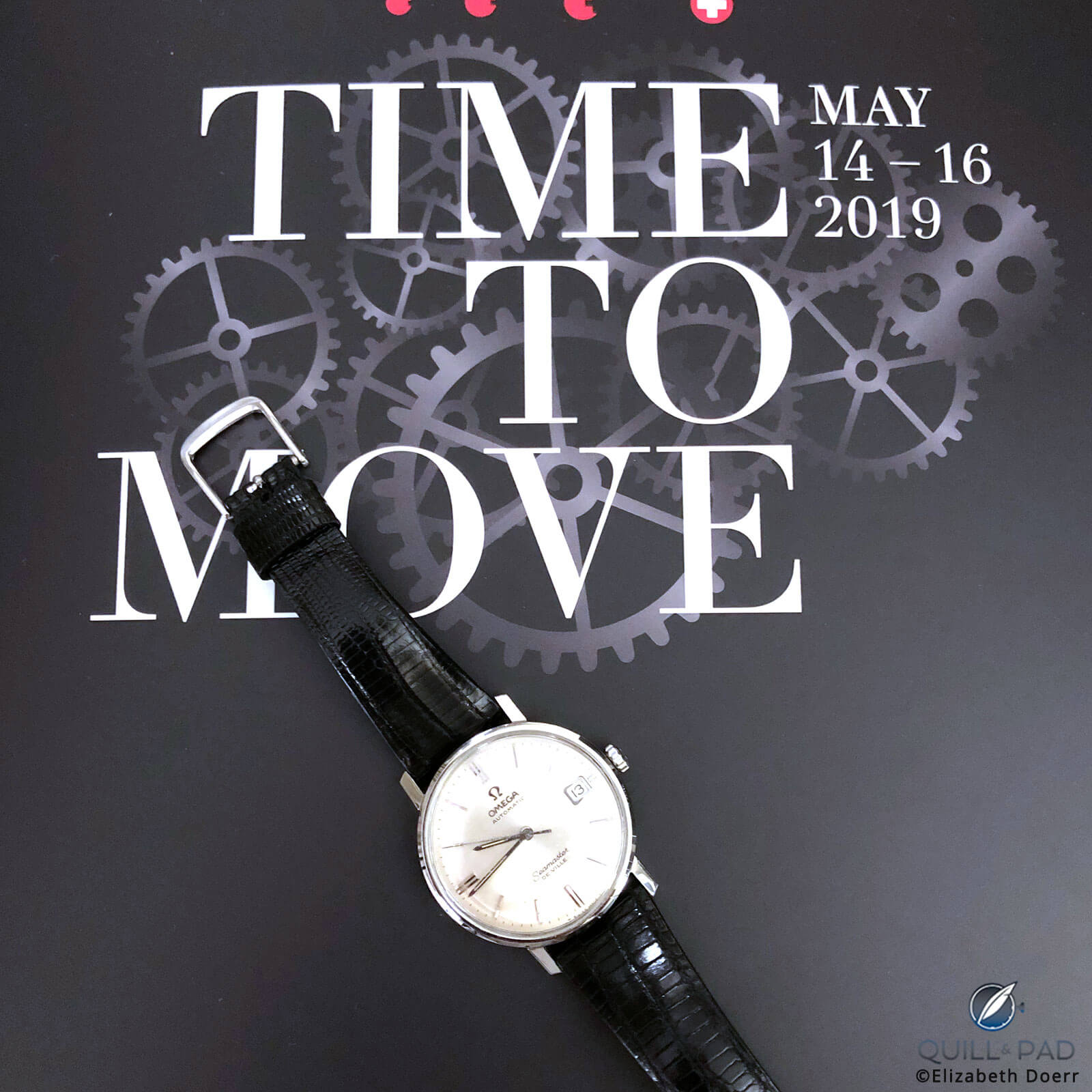
The Swatch Group decided it was “time to move”
MG: So, what were your expectations for Time to Move?
ED: I didn’t really know what to expect because this is the first time the Swatch Group has taken on something of this magnitude, essentially making a fair of sorts with its six top luxury brands. This included showing us the new products for the year, but also going behind the scenes and checking out five of the six factories of the brands involved – Glashütte Original is located in Germany so it set up in Geneva’s Starling Hotel.
I will admit that I did not have any real expectations. You?
MG: Not so much. I was a bit worried when I got the full itinerary and saw how busy the schedule was. But at the same time to see so many brands in such a short period and see them in their natural environments – where the watches are being made –was quite a unique experience, even for experienced watch journalists.
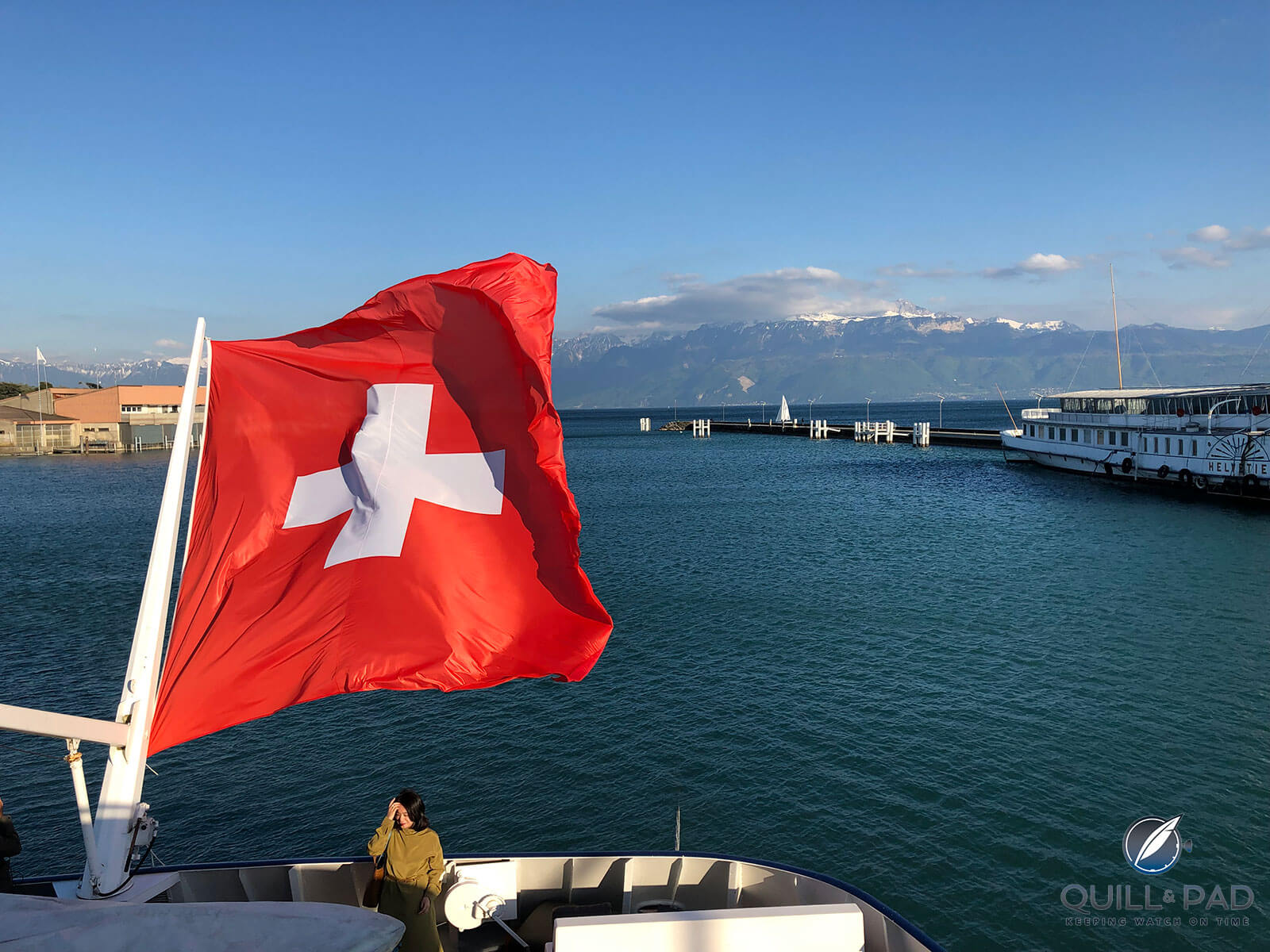
A windy evening in Lausanne
I also think it gives the brands the opportunity to present themselves in their own ways. So, I kind of went in blank, but I must say that my expectations were high on one side but on the other side I also realized that the Swatch Group pulled out of Baselworld relatively late. So the brands didn’t have that much time to prepare how they were going to show us the watches.
The watches were already in development so the product would be there, but to present them in a completely new format must have been very challenging and that made me especially curious.
ED: Yeah, I know what you mean. By the time we arrived (almost 200 journalists came in the night before the first day), my excitement level was starting to get high. And when we got to Switzerland, we discovered this phenomenal weather with fairly consistent sun and a very strong wind, what’s known as a bise, coming down off the Alps, which cleared the skies of clouds and allowed the entire mountain scenery in the backgrounds of all these beautiful cities to come to the fore. That was a rare and beautiful sight.

Sublime view over Lausanne
The first day and a half all of us were quite taken by the Swiss scenery in its natural springtime state, which we don’t see very often. So by the time we got into the first bus headed to the Vallée de Joux for Breguet and Blancpain it wasn’t feeling like a fair anymore; it felt more like a factory visit day out.
MG: It did have a very intimate feel to it, and I thought that traveling to the manufacturers located in Switzerland’s beautiful countryside kind of built up the anticipation. Driving through the fields and villages cleared the mind and set the scene for what we were about to see.
Plus I think it really put the watches in a completely different context than Baselworld: rather than the enormous stands, a lot of visitors, a lot of marketing people, a lot of management, we entered the manufactures where the watches are really being made by the craftspeople that work there day in, day out. And I think that provided a much different vibe.
In the end, my expectations were exceeded. Thinking toward the future, the only issue that I see, of course, is that this kind of thing is not for the public; Baselworld allows the public to enter, although even there it’s kind of limited as to what they can see compared to us journalists.

Sunrise over Lausanne
But I do think I have a much better feel for the watches and the way they were created by visiting and seeing them in their natural environment at the manufactures where they were created than I actually would have had at a fair. And because we could dedicate more time to each brand.
ED: Nonetheless, I still found the time that we spent with each brand at times a little short. Some of the brands had just a few new things, but there were a couple of brands like Omega and Harry Winston who had in excess of 20 new watches each. We were in the factory for three hours total, in which time we did a visit and we learned about the new watches. I felt it was rushed sometimes.
MG: Also, it is not unimportant to note that we now live in a digital age in which social media is not just essential but critical, which also means that photography has become increasingly important. And to that point it was sometimes also challenging.
Blancpain
ED: Our first stop was Blancpain, which we reached by heading into the very scenic Vallée de Joux. Blancpain has two factories there, one in Le Sentier – the old Frédéric Piguet factory – where they make the movements, the components, do the assembly, etc. And then we headed over to Le Brassus, where Blancpain’s second factory is located. Called “the Farm” because it’s an old farmhouse and it looks very quaint, this is where the high complications come to life.

Marc Hayek (right) personally presented Blancpain’s new watches
MG: This is also actually where we saw the added value of doing this concept, because the president of Blancpain, Marc A. Hayek, actually presented the new products to us himself, which is something that rarely, if ever, happens at Baselworld.
ED: That was kind of thrilling having Marc Hayek do our first presentation: we walked into the room and there he was standing there with the new Fifty Fathoms Barakuda (Reference 5008B).
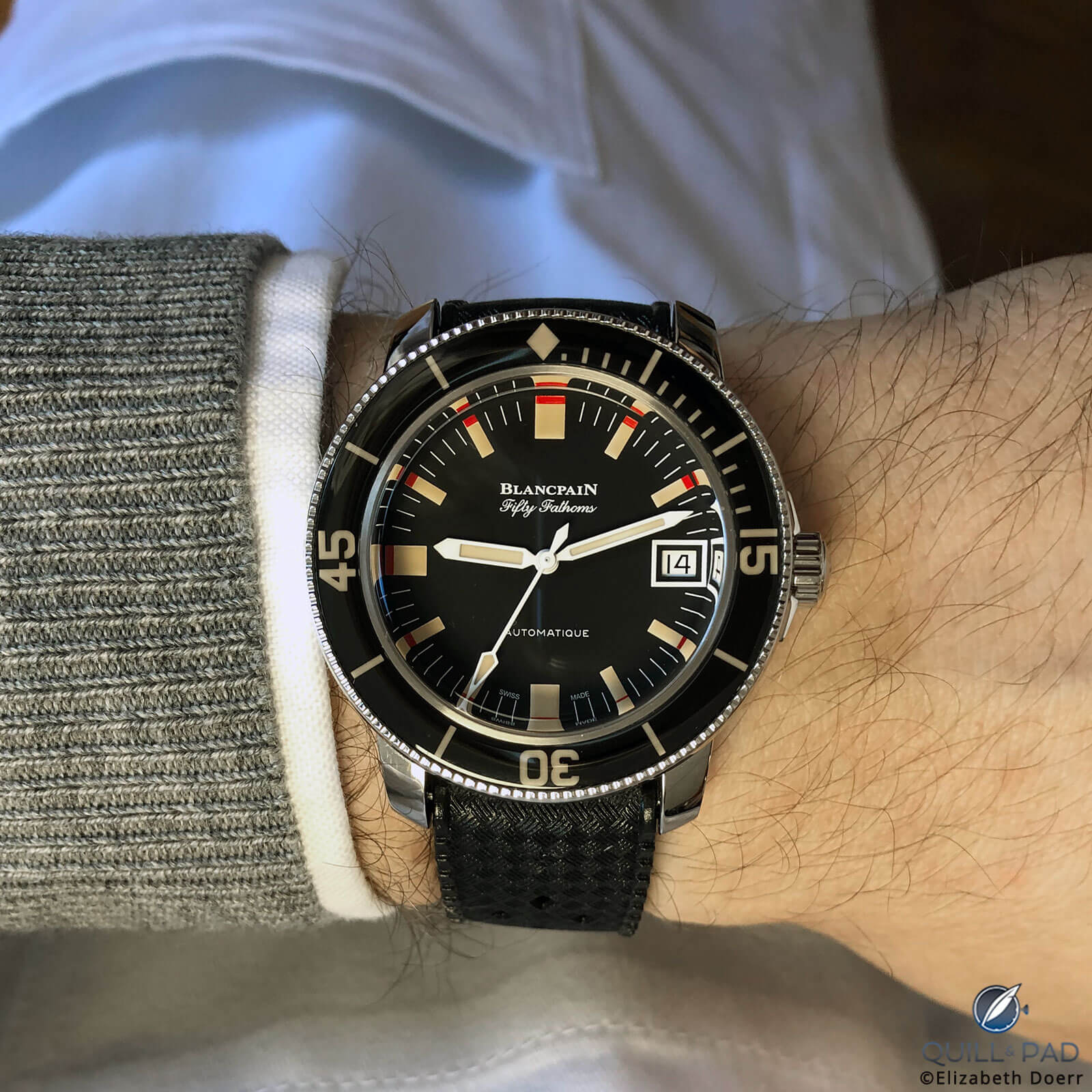
Blancpain Fifty Fathoms Barakuda Reference 5008B
MG: . . . very passionately talking about it. Also because it’s a reinterpretation of a vintage diver’s watch by Blancpain, and he’s a very passionate diver himself. So that adds to the experience, plus it gives you a layer of background information that you would otherwise not get.
ED: So from that standpoint it was a much nicer thing than just the usual Baselworld fair site.
MG: And then they brought in the new Air Command Reference AC01, which I think is simply stunning. Not only on the dial side but also the movement with its oscillating weight is absolutely spectacular.
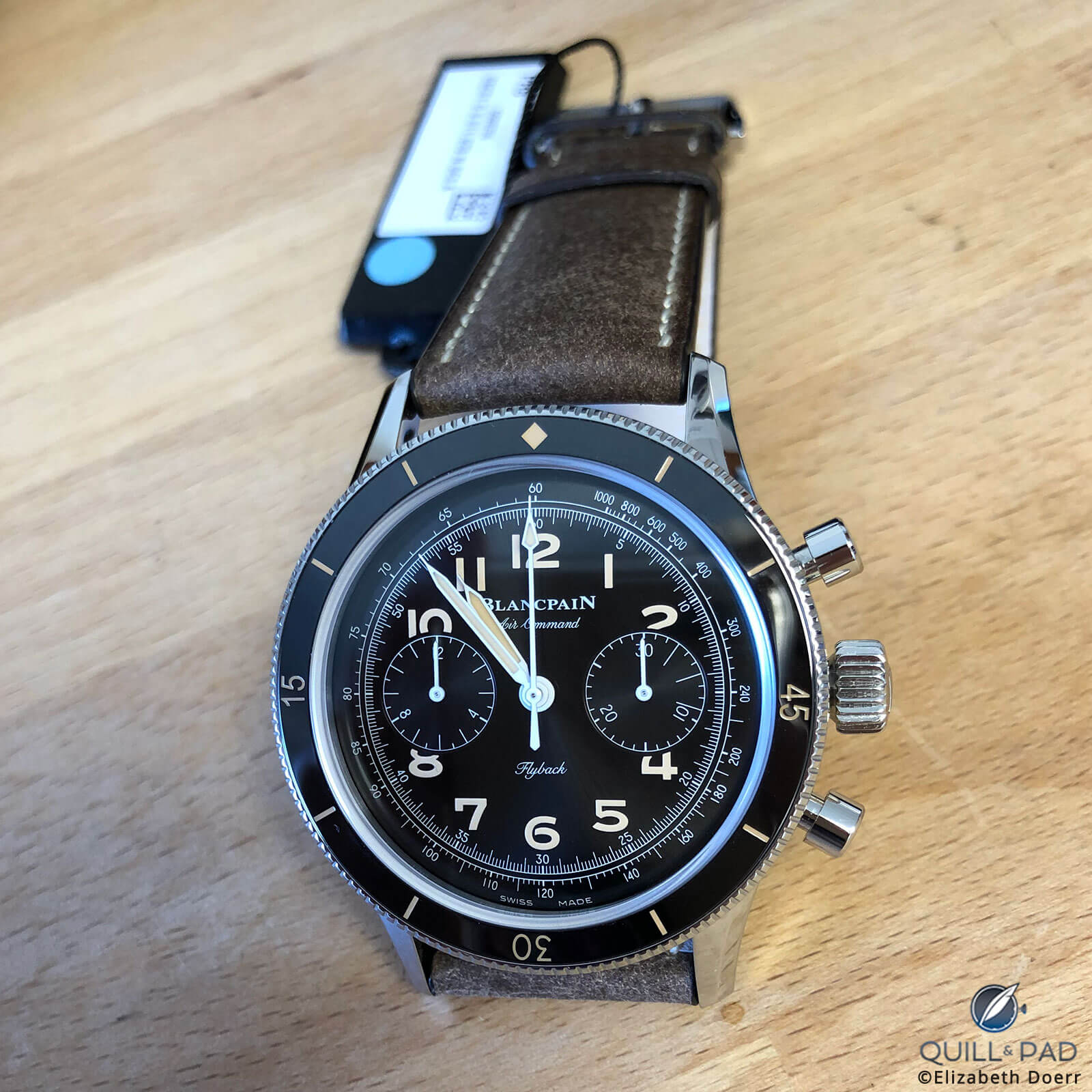
Blancpain Air Command Reference AC01
ED: Blancpain was one of the manufacturers with just a few new watches this year, so aside from the two new sports watches we just talked about, there were a few new line extensions. And it is here that I have to really, really call out the new mesh-style bracelet!
MG: The bracelet is awesome. It’s so well made, so subtle yet solid at the same time, has the perfect heft to it that it adds another dimension if you add it to one of the Blancpains – not only visually, but also in a way you experience the watch on your wrist.
ED: If I could take that bracelet and put it on every watch I own, I would do that.
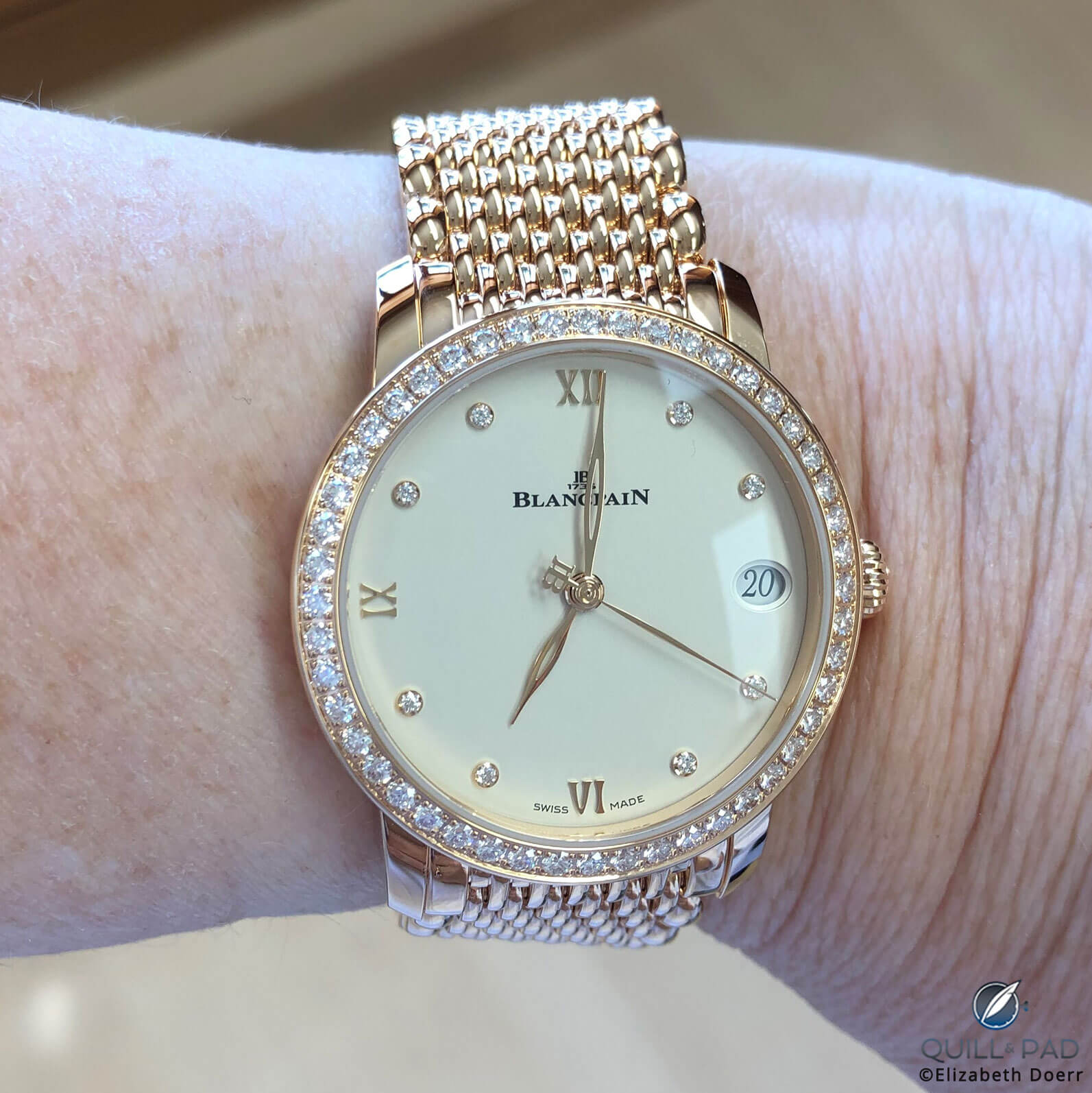
Blancpain Villeret Women Date Reference 6127: I wonder if I could just buy that bracelet?
MG: Definitely. You know I might even get one without a watch for my other wrist.
ED: I wonder if they’d let us do that? (laughs)
Breguet
ED: Anyway, after a charming lunch in a tiny little restaurant in the middle of the woods, we went on to visit Breguet, where again we were greeted by the entire upper management, including the one and only Emmanuel Breguet along with Thierry Esslinger, who took over the brand’s CEO position in 2018.
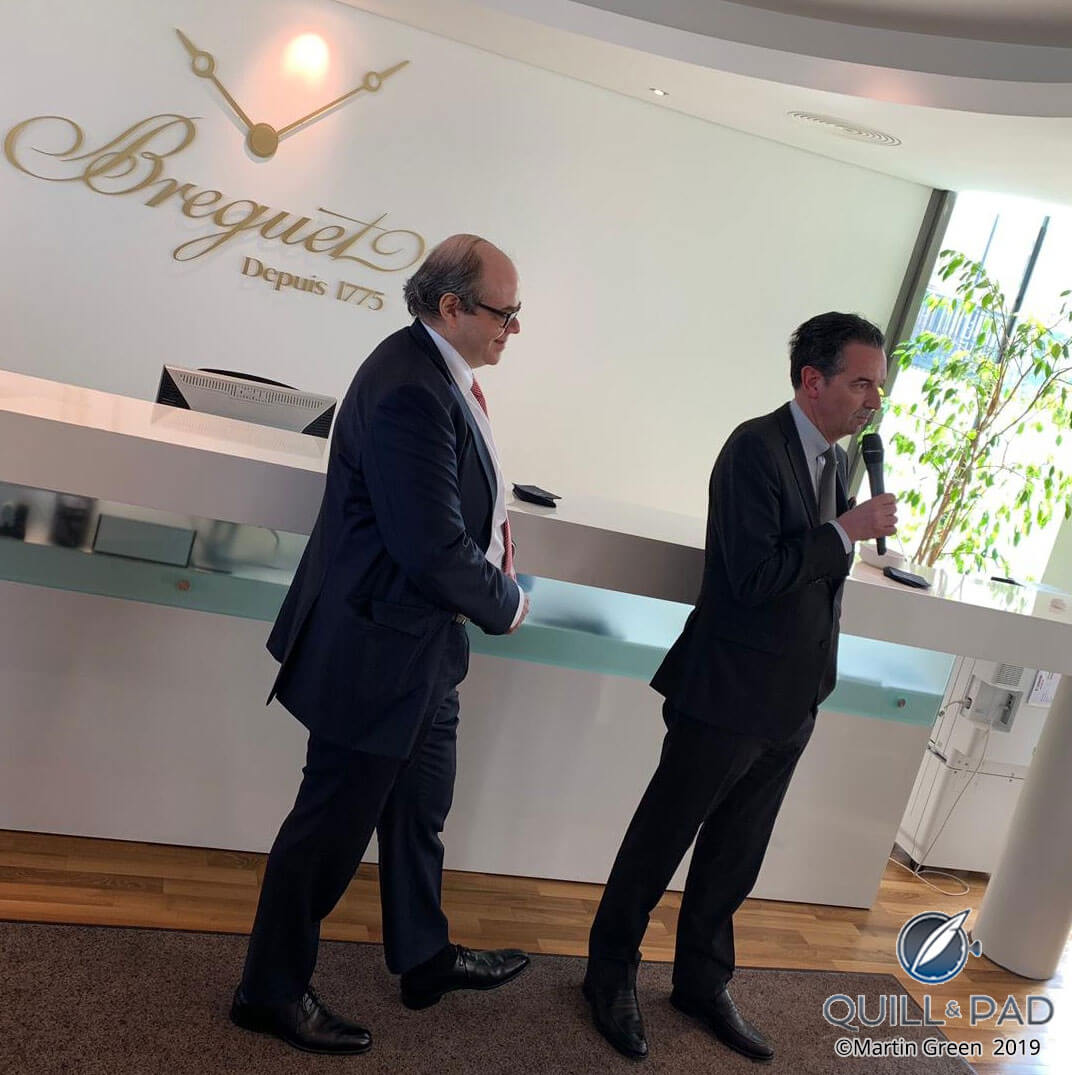
Breguet CEO Thierry Esslinger (left) with Emmanuel Breguet
MG: Yes, he’s always a pleasure to talk to because as a descendant of Abraham-Louis Breguet he has an encyclopedic knowledge of the history of the brand and the family.
Breguet also gave us a tour of the manufacture so we could see how the guilloche dials are made using vintage and new rose engines. Even applying it to mother-of-pearl, which is absolutely stunning.
But showing us that particular station was not without reason: the brand introduced a couple of new dial styles that are, well, very captivating: the play of light, the use of color, the intricacy of the decorations all come together.
ED: What I thought was super interesting, because we went through the factory first before we saw the new models, was that the craftspeople were working on the new models. So we could see the guilloche being added to certain parts of the movements and to the mother-of-pearl dials.
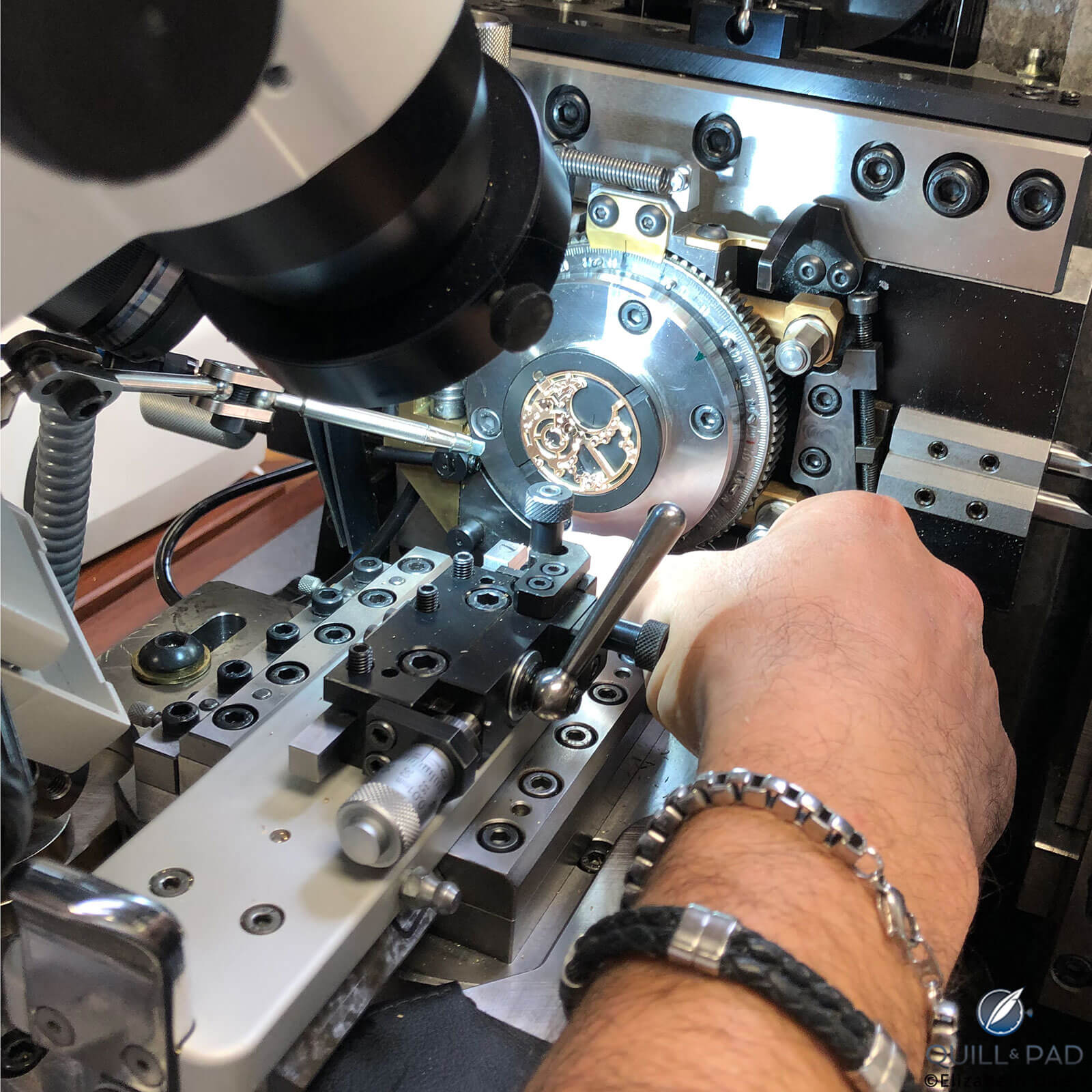
A Breguet artisan applying guilloche to the plate of the Classique Tourbillon Extra-Plat Squelette
We saw them working on various other movements that we came to see later in the new watch presentation. At the moment we saw them we, of course, did not know that those belonged to those watches, but later when we pieced it all together it added to the depth of knowledge we received on those watches.
MG: One of Breguet’s new introductions is a titanium bracelet for the Marine collection, which changes the character of the watch for me.
ED: Absolutely.
MG: It becomes a little bit more utilitarian. But at the same time, I thought it was quite clever because it is a kind of natural extension. Of course, we’ve had bracelets on the previous generations of the Marine, but I like this one. It was well made, and especially combined with the gray dial it provided a sporty edge that we don’t really seeing that often at Breguet.
ED: Yeah, but that’s sort of an extension of what they started doing last year in the Marine collection: making it sportier – more masculine, more noticeable. I would never call a Breguet watch utilitarian, but the addition of the bracelet made it more like an everyday wearer, rather than the watch you pull out at night. I think that was what they were going for.
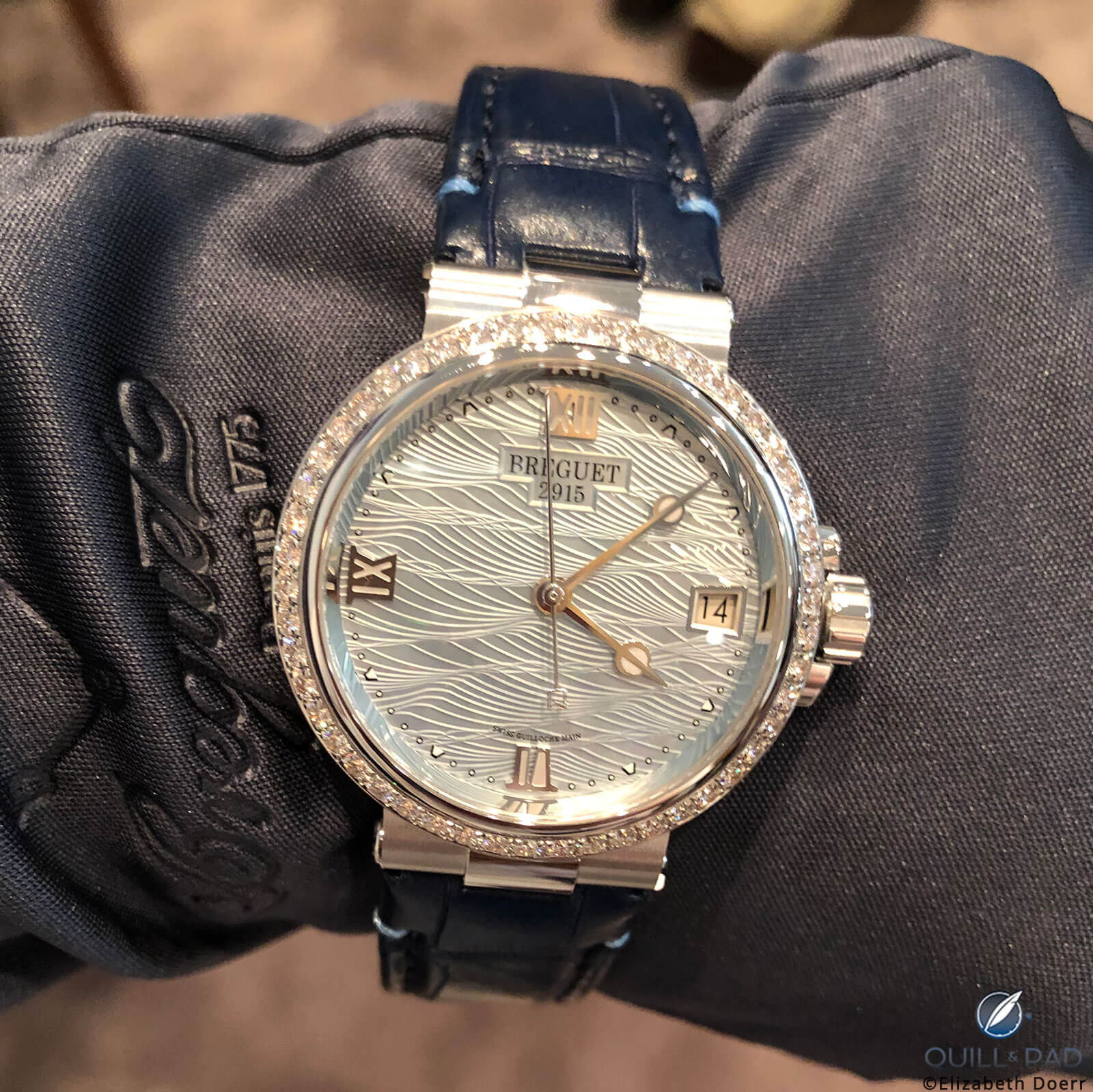
The updated Breguet Marine line for ladies is all about dial texture
Breguet also had a lot of new extensions in the ladies’ Marine collection, which in its previous carnation was also very beautiful but now it’s become much more elegant, modern, and contemporary. Those beautiful new dials, some of which are decorated with a brand-new save-like guilloche Breguet invented for the line, show off a variety of colors and textures that is nothing short of outstanding.
MG: And because it was Breguet, there was of course a new tourbillon: a beautiful, skeletonized Breguet Classique Tourbillon Extra-Plat Squelette that is a variation of an existing watch. But the craftsmanship, again, takes it to the next level. And I kind of feel like we don’t see enough skeletonized tourbillons anymore.
You know it was something of a trend in the early 2000s; many brands had this style of watch in their collections. The contemporary way Breguet has made this one kind of makes you think again about how beautiful the style is.
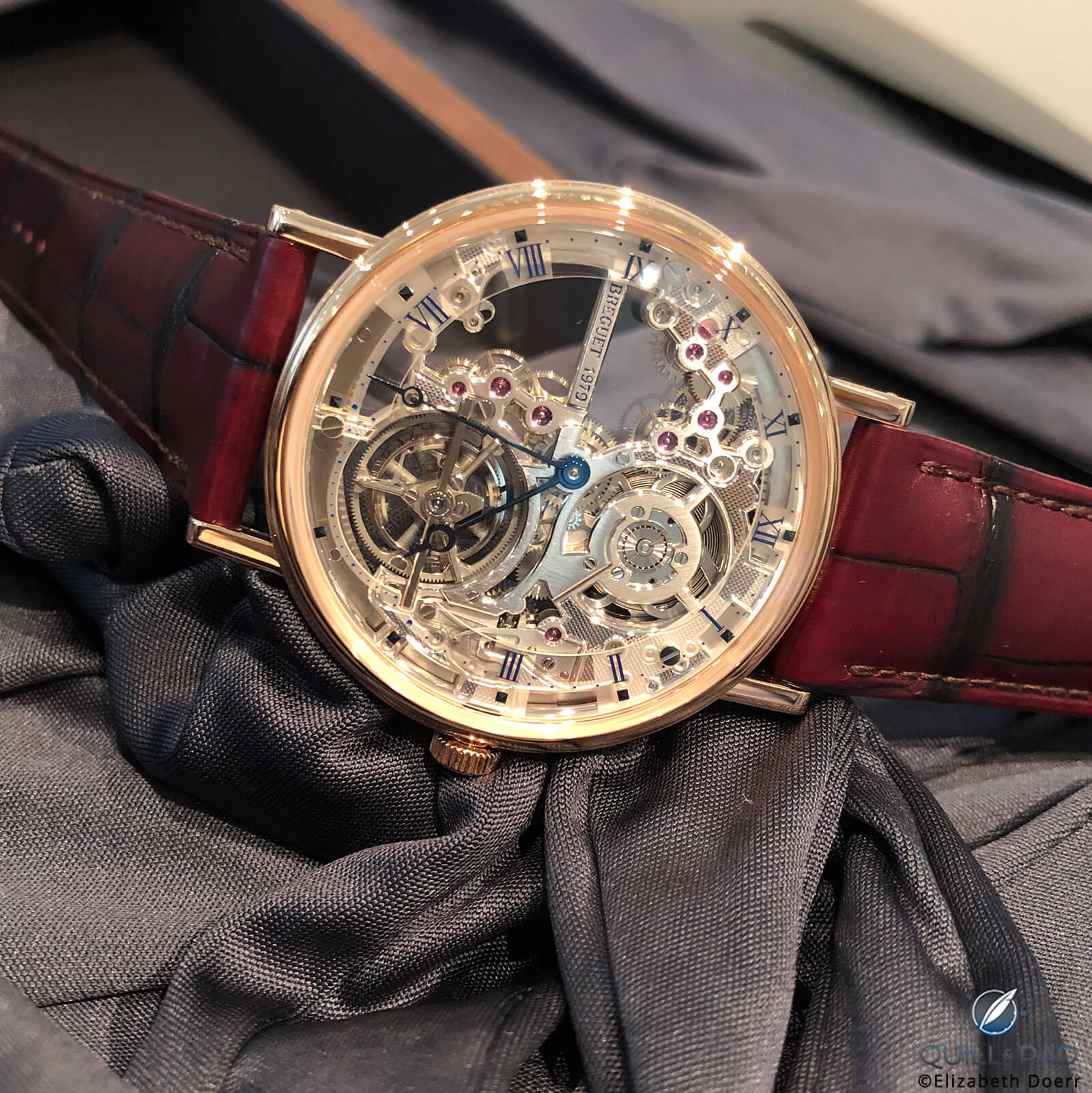
Breguet Classique Tourbillon Extra-Plat Squelette
ED: Yeah, how beautiful was that back then? But how well Breguet has managed to take that idea from 15 years ago or so and make it totally into something for today. And that’s one of the big reasons why the Breguet Classique Tourbillon Extra-Plat Squelette is one of my personal favorites of the week. It’s a stunner – and maybe because it is so skeletonized that you could see a lot of the wrist underneath, which I always think is a very beautiful way to present horology, though I know it doesn’t work for everyone.
MG: You need to have a beautiful wrist.
Omega
MG: Day two started with Omega and the new manufacture. Or, perhaps more precisely, the new building as the old ones are still operating.
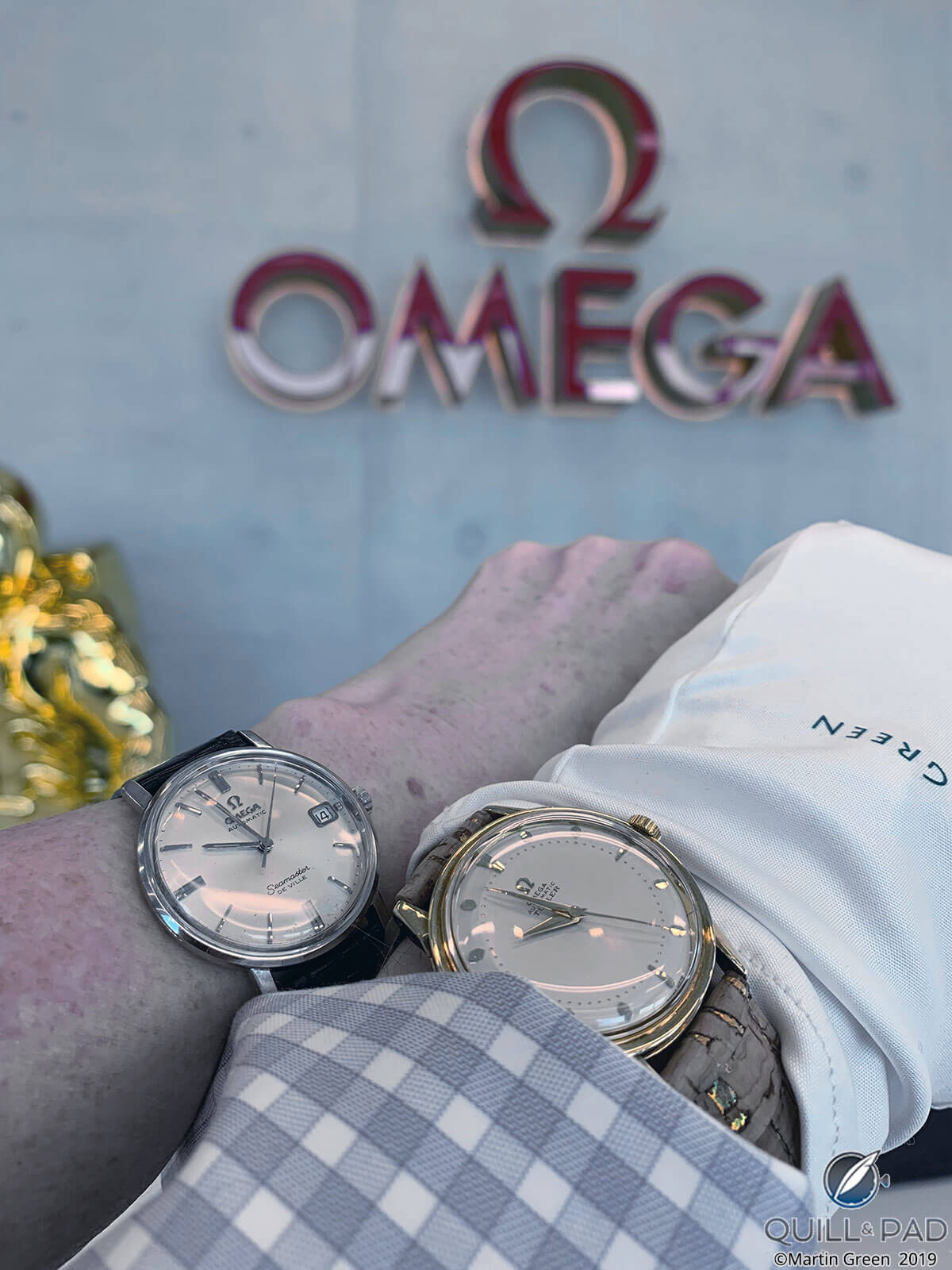
Elizabeth Doerr and Martin Green go vintage for the visit to the new Omega factory
Omega gave us a tour, and we learned a lot about quality control, the Metas Master Chronometer Certification, and the process all the watches have to go through to obtain that.
But there were a lot of new watches; every line got so many additions to it that it was absolutely mind-blowing, especially because the quality of them across the entire collection was very high. What I did find very interesting was that there were a lot of upmarket additions. So, there were a lot of precious metal cases not only in the classic lines like the Constellation, but also in the Seamaster and the Speedmaster lines with the use of semi-precious stone dials and gemstones as well as precious metals.
It was almost like Omega wants to work its way up the ladder, also appealing to a clientele who usually buys more expensive watches made from more precious materials.
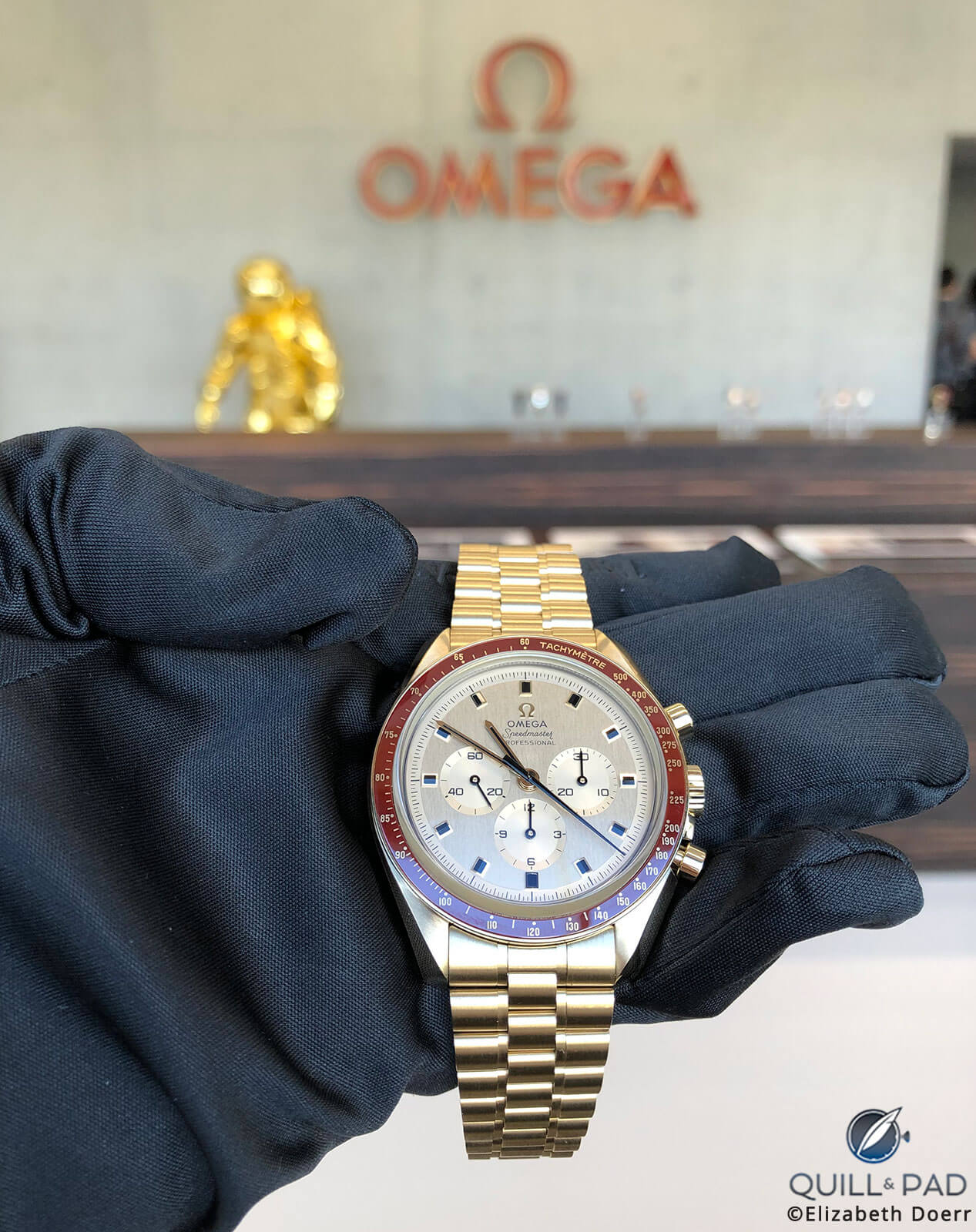
Omega Speedmaster Apollo 11 50th Anniversary edition in Moonshine Gold
ED: That new use of more precious materials also really stuck out to me. There was a new metal called Moonshine Gold used for the case of the new limited edition Speedmaster Apollo 11 50th Anniversary – Moonshine Gold being the name of the brand’s new special kind of yellow gold.
In the Seamaster collection we had a new platinum gold, which is a new platinum alloy with a small percentage of gold. But what was extra crazy about the watches in these cases is that they also had new hardstone dials like lapis lazuli and malachite. This gave these new watches a really elegant look that we hadn’t seen before in this collection.
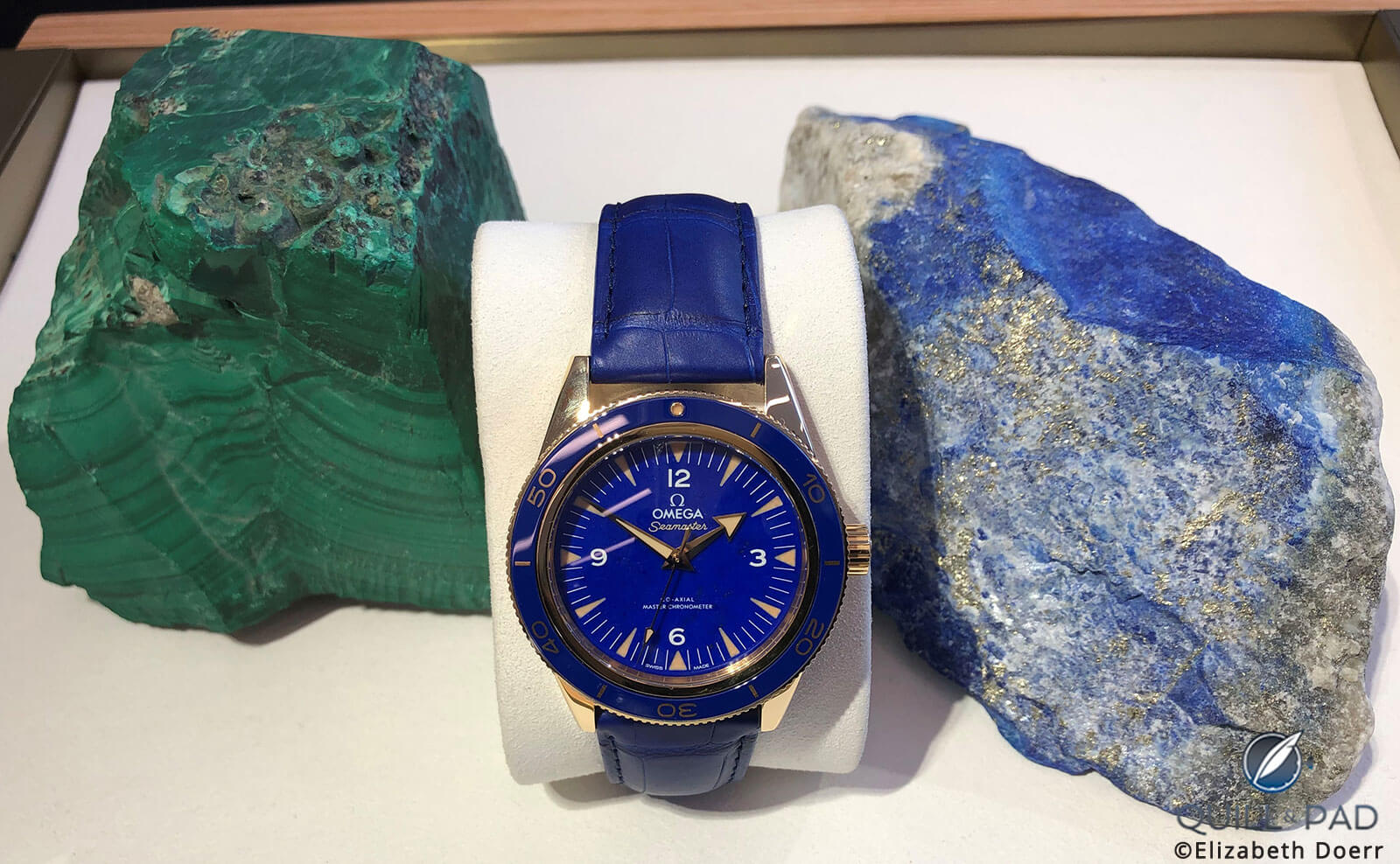
A 2019 Omega Seamaster between malachite (left) and lapis lazuli
And then there was the De Ville Trésor line with these cool structured dials in blue and burgundy, which I liked very much.
MG: They are gorgeous.
ED: So Omega is really upping its game in the elegance department, but it didn’t fall short in the sports watch area either.
MG: There were a lot of new Seamasters, and one of the nice things is that Omega now introduces a chronograph in the new Seamaster Diver style, which I thought was very well integrated.
The brand also launched two new Planet Oceans: a chronograph and a time only, but I must say that my absolute favorite is the ceramic titanium Omega Seamaster Diver 300 m. A lot of people don’t know that about me because they always think I’m a dress watch kind of guy – which is actually true – but I also have a weak spot for Omega Seamasters, and this one was really calling my name.
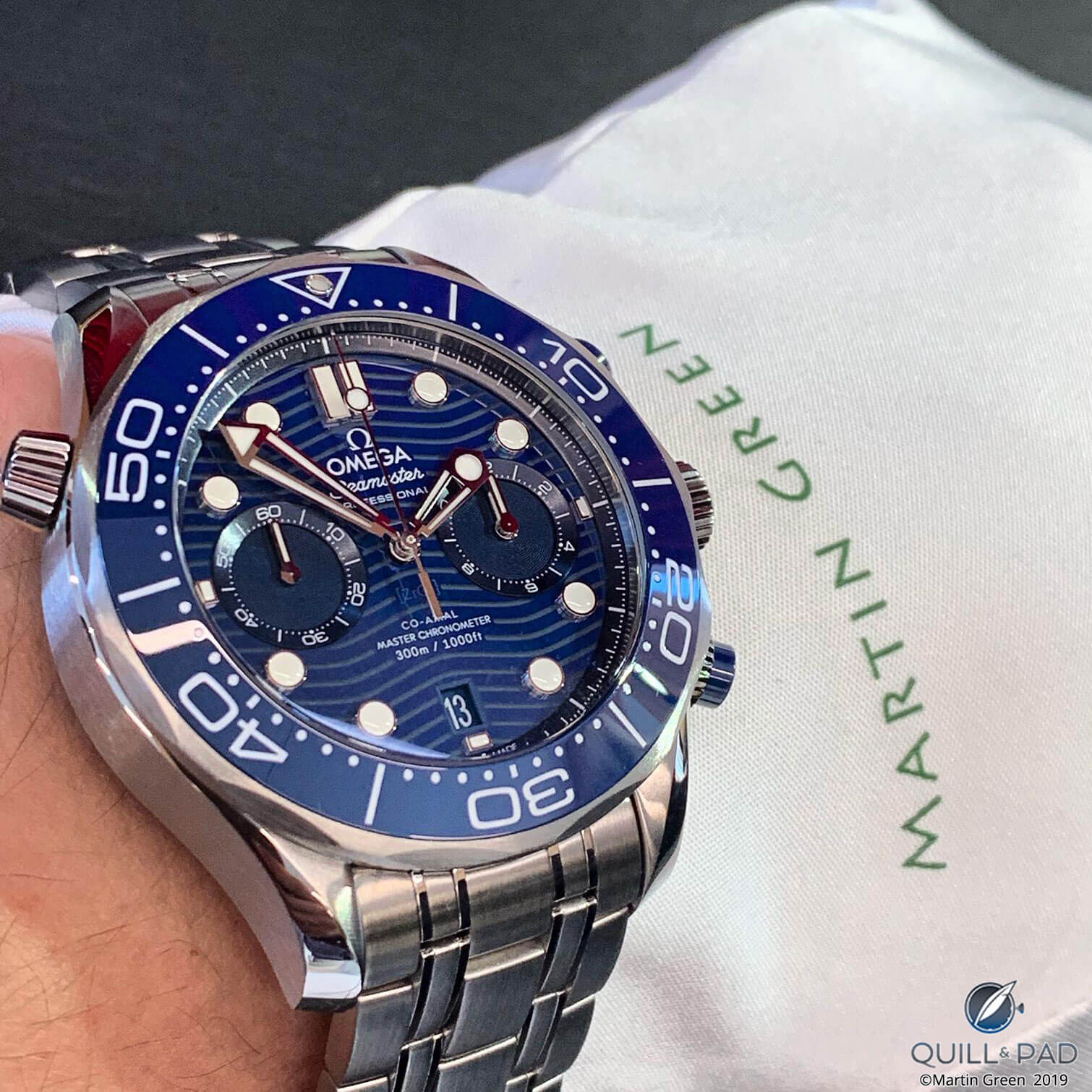
Omega Seamaster Diver 300 m in ceramic titanium
I love the weight, I love the way it is made, and the looks are good. I love it that the waves are back on the dial, I love it that they exist both in positive as well as in negative executions in this collection, depending on the model, and I think Omega is really on top of its game.
ED: Overall a very impressive visit to Omega.
MG: I’m going to say we probably right now sound overly positive, which might make some of our readers suspicious – as if we are perhaps getting paid to say all this. But believe it or not, we’re not: these are really nice watches, really nice products, and I actually think that if the Swatch Group had been as usual in Basel a lot of these watches would have been the talk of the fair.
Jaquet Droz
ED: And speaking of the talk of the fair, in the afternoon after the Omega visit we moved over to Jaquet Droz, which is up in the hills above La Chaux-de-Fonds.
MG: Which made for a great comparison: if you look at the high-end brands of the Swatch Group, Omega is by far the largest with the highest production, while Jaquet Droz is actually the smallest with the lowest production numbers.
ED: Jaquet Droz showed us a watch that I think we both nominated as a personal favorite and would definitely have been the talk of the fair had it been at Baselworld: it certainly would have landed on everybody’s “favorite list” at Baselworld this year.
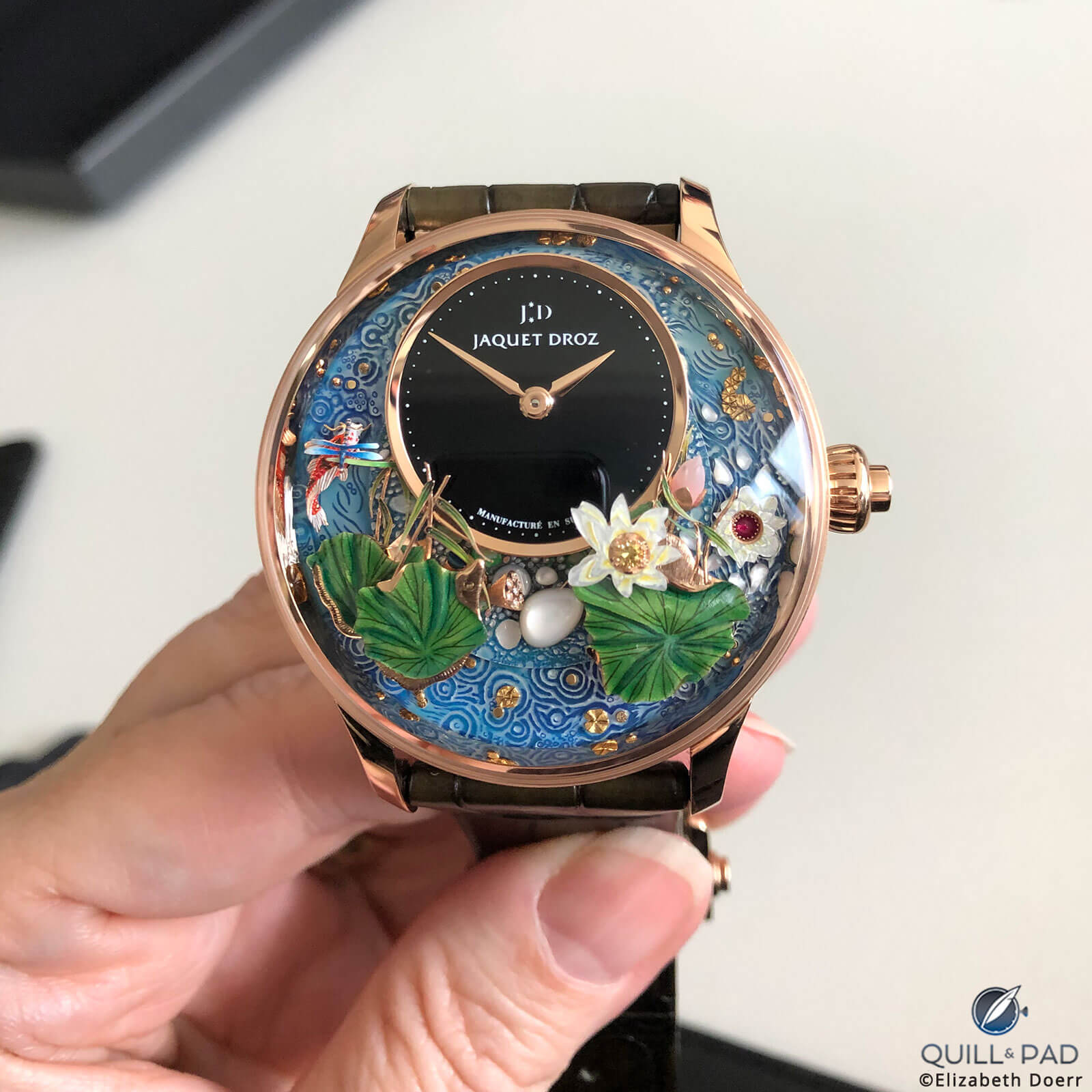
Jaquet Droz Magic Lotus Automaton
Called the Magic Lotus Automaton, it was another watch from Jaquet Droz with an animated dial: its scene includes a koi fish, a dragonfly, and most intriguingly a lotus flower that moves around the periphery of the dial whose pistil changes between three colored gemstones. It’s like magic!
MG: Yes, it is absolutely stunning. What was most stunning about it was not only that it had different levels, but also that the koi carp was actually moving in a way that was so natural, even swimming up and down on the dial. The execution was perfect.
The lotus flower’s changing gemstones made it so that the dial never looked exactly the same. And what was also very impressive was that if you wind it completely the animation runs for four minutes.
And the nice thing about the watch is actually that despite being so beautiful and complicated, it wasn’t unwearably large. I mean, of course, it’s a large watch because it does a lot and it also needs the room so that you can actually see the animation well, but the way it was made it was still something that you could easily wear and enjoy.
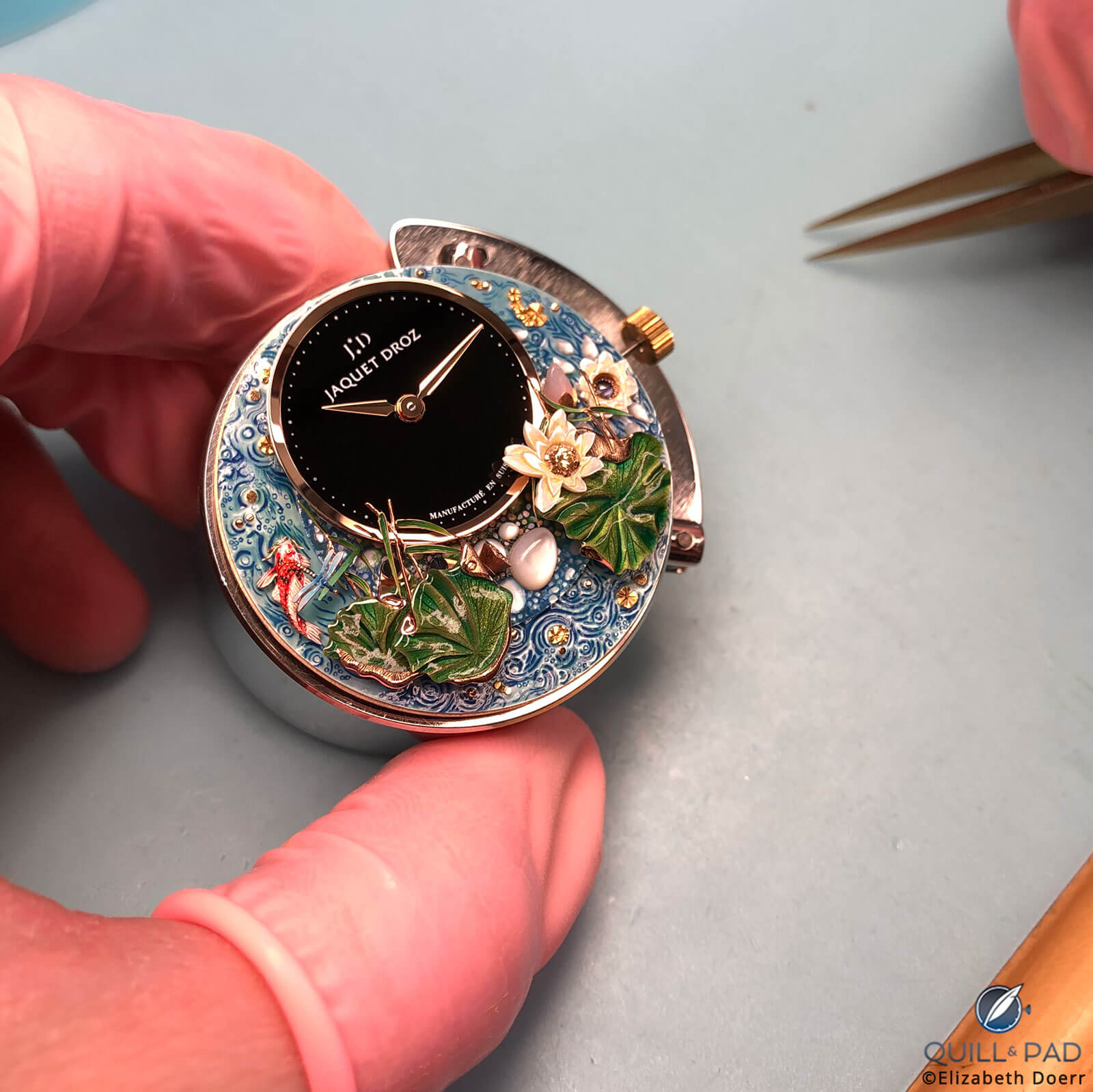
The dial of the Jaquet Droz Magic Lotus in the workshop
ED: Yeah, it was incredibly charming. But something else that caught our eye at Jaquet Droz was that brand-new chronograph, which I didn’t think would have been a possibility in that form.
MG: Jaquet Droz knocked that one right out of the ballpark in terms of design; it is absolutely stunning. I also think it is interesting that two versions of it are being introduced simultaneously: an off-center one and a symmetrical one, both so appealing. The difference between them is technically none, other than that they kind of switched the movement around and therefore the dial.
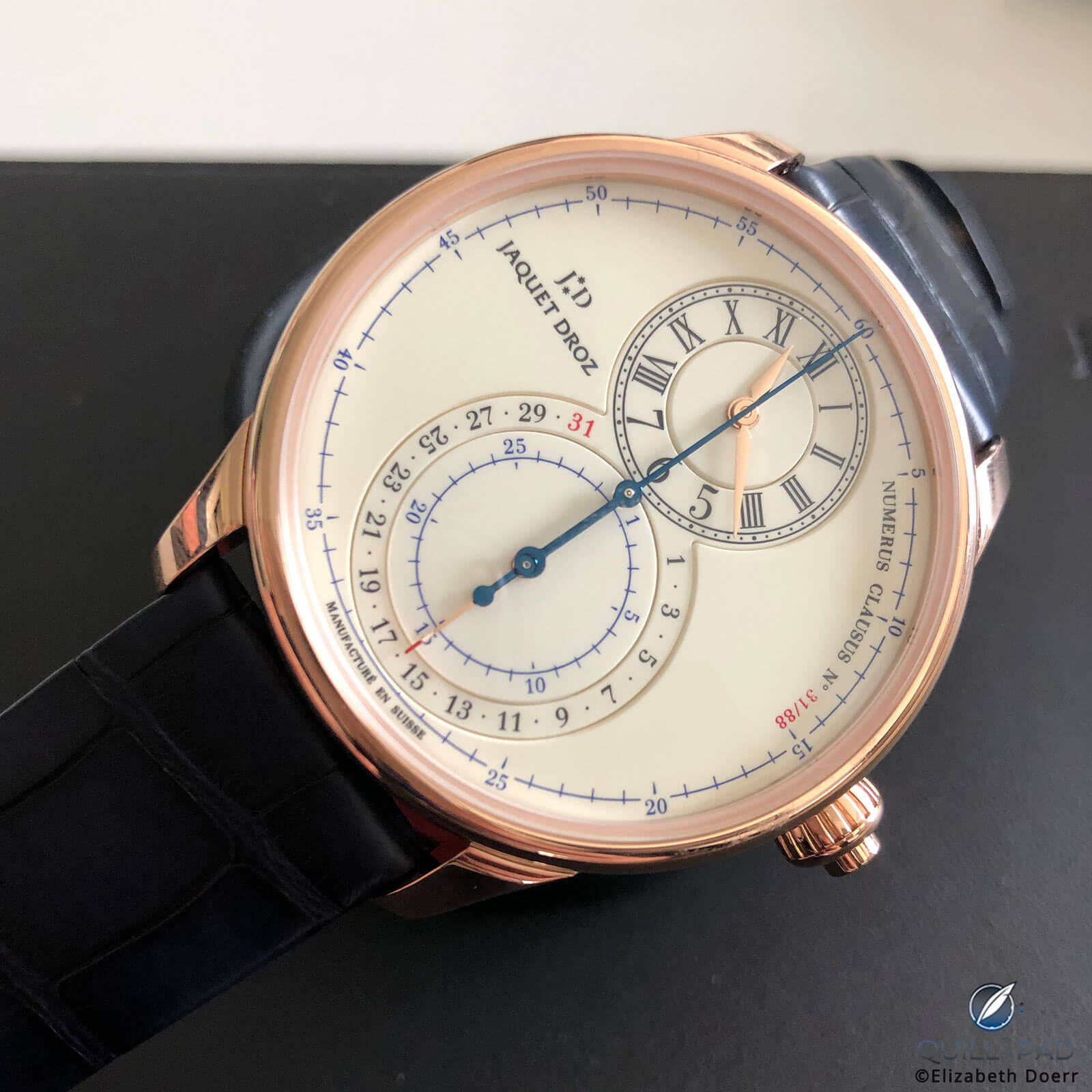
Jaquet Droz Grande Seconde Chronograph
ED: Basically, they took the Grande Seconde – the classic Jaquet Droz style – and added the chronograph right into those same subsidiary dials, not disturbing the look whatsoever. If you don’t look at it very carefully you might not even know there’s a chronograph in it, also partially thanks to the the monopusher.
Harry Winston
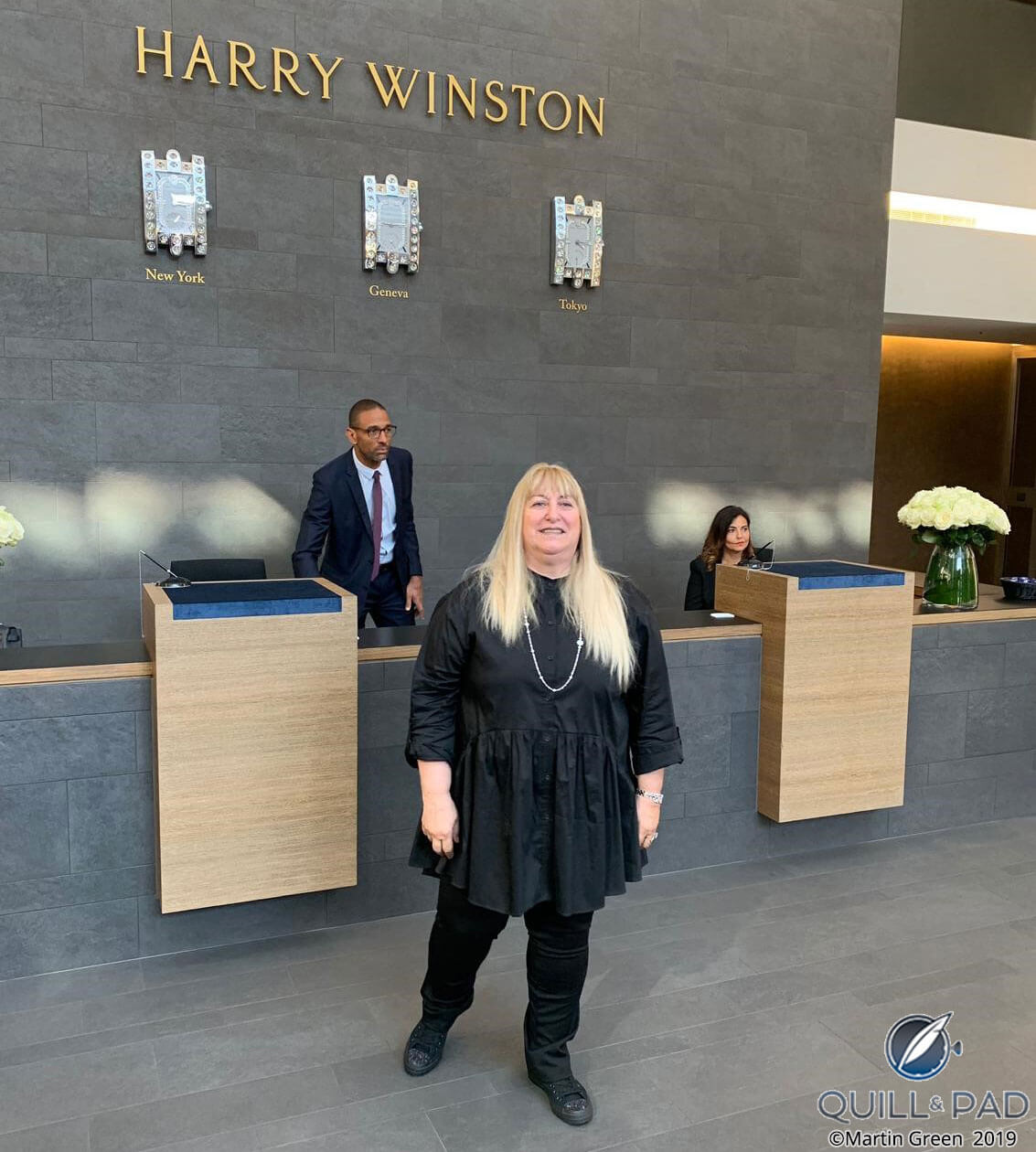
Nayla Hayek greets the journalist group at Harry Winston
MG: The final factory on the last day was Harry Winston, where we had the privilege to visit the gem-setting workshop where the famous sparklers are set. And in fact the Time to Move visit constituted the very first time press was invited in. Ever.
Nayla Hayek, president of this brand, was visibly very passionate about these products.
One of the things about Harry Winston that really struck me was not just the in-house gemstone expertise – there is an onsite diamond cutter onsite to make sure everything is perfect, for heaven’s sake! – but the large volume of additions to the 2019 collection.
Because of the prolific use of gemstones, it’s not a brand that appeals to everybody, and it’s also not a brand that many people can actually afford: the price tags going along with the precious stones is justifiably pretty high.
ED: It was breathtaking, and I think the fact that we were allowed to go in and see how the setters and gem cutters work – there was a man cutting a diamond as we were standing behind him talking! – just blew me away.
MG: Nerves of steel.
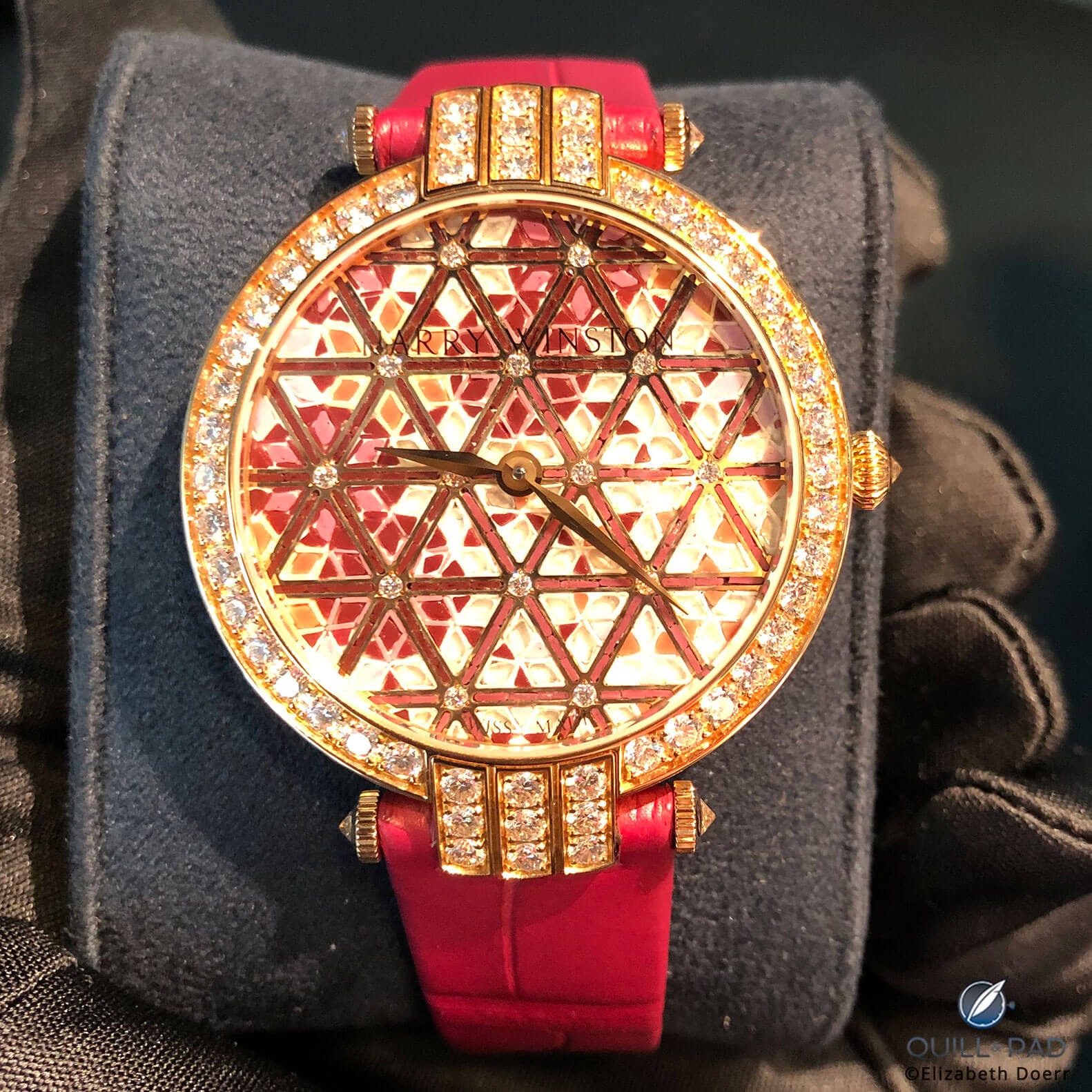
One of four versions of the Harry Winston Premiere Precious Micromosaic Automatic 36 mm
ED: But I was so impressed to learn about how these things are made and then see them in their finished versions. It was way more interesting than I ever thought it would have been. You know not being so interested in jewelry, and more in watches, this combination of jewelry with watches became a lot more interesting by learning more about how things are done. One of the watches that really caught my eye while we were there was the Premiere Precious Micromosaic Automatic 36 mm featuring a miniature mosaic of glass translucent and opaque tiles that takes one week per dial to complete.
MG: Oh yeah, that was gorgeous.
ED: And the Premier Hypnotic Opal Mosaic Automatic 36 mm features a dial made of 113 different parts of a very rare opal put together in a mosaic alongside 72 baguette-cut diamonds, 72 baguette-cut blue sapphires, and 24 princess-cut diamonds.
That’s not a watch I would have generally singled out from an entire fair full of watches, but because we were concentrating on it for so long and watched how they were putting it together it stuck out in my mind as a highlight.
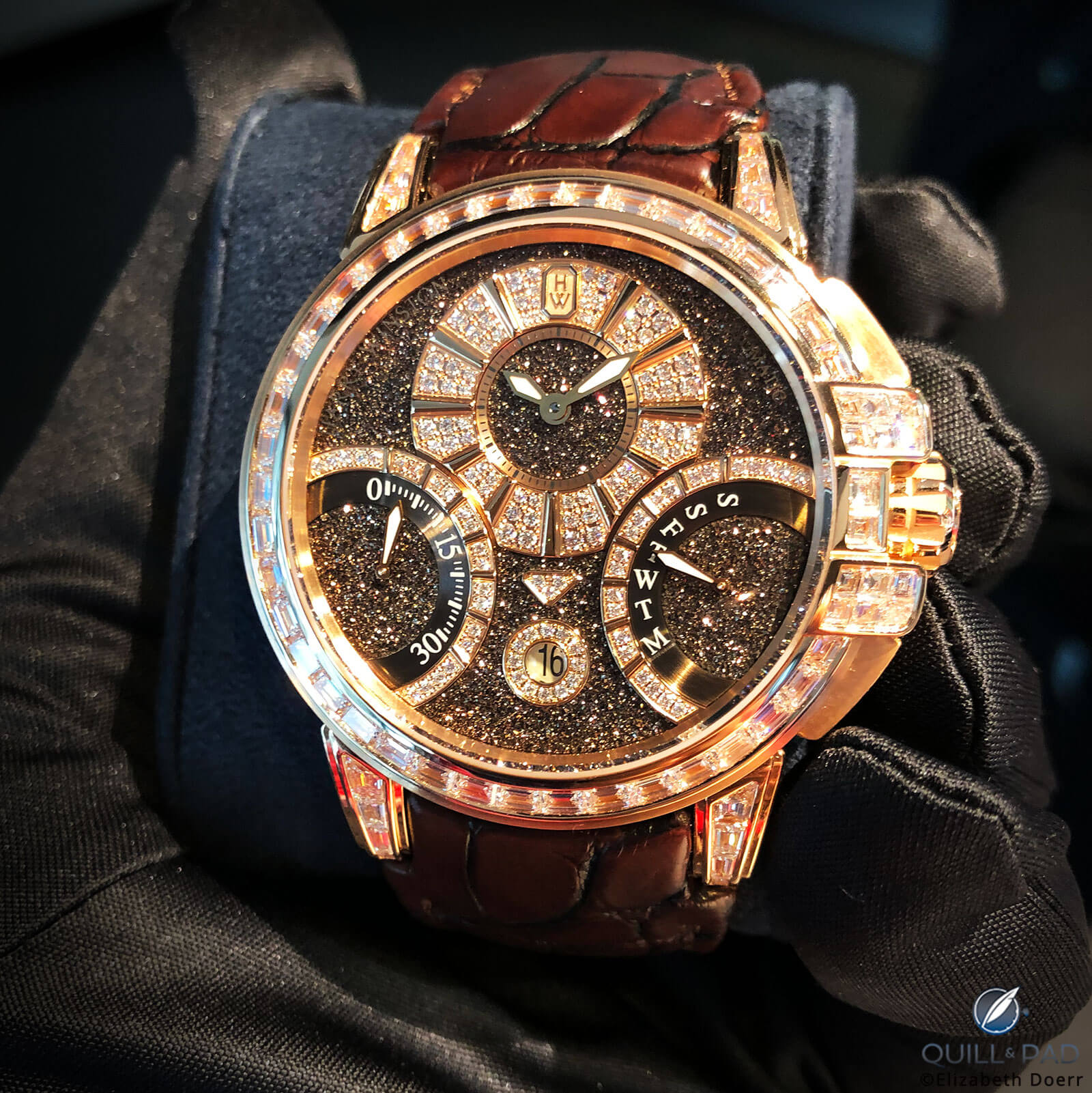
Ruthenium crystals makes the Harry Winston Ocean Sparkling Biretrograde Automatic 42 mm sparkle
MG: Then there was the Ocean Sparkling Biretrograde Automatic 42 mm, which was absolutely stunning in the way it was constructed and the way the dial was created uniquely using ruthenium crystals.
It looked very simple, but technically it was very difficult to make because of the double retrograde and the power that it needs to build up through time to actually do the work. Additionally, it was well executed and proportionate, so I’m very impressed.
ED: And then there was a limited edition of ten pieces called Midnight Yozora featuring his-and-hers watches with a Japanese Urushi lacquer dial and mother-of-pearl inlays and a matching pen made by Japanese penmaker Nakaya. It was beautiful, just beautiful. I didn’t expect to see something like that there.
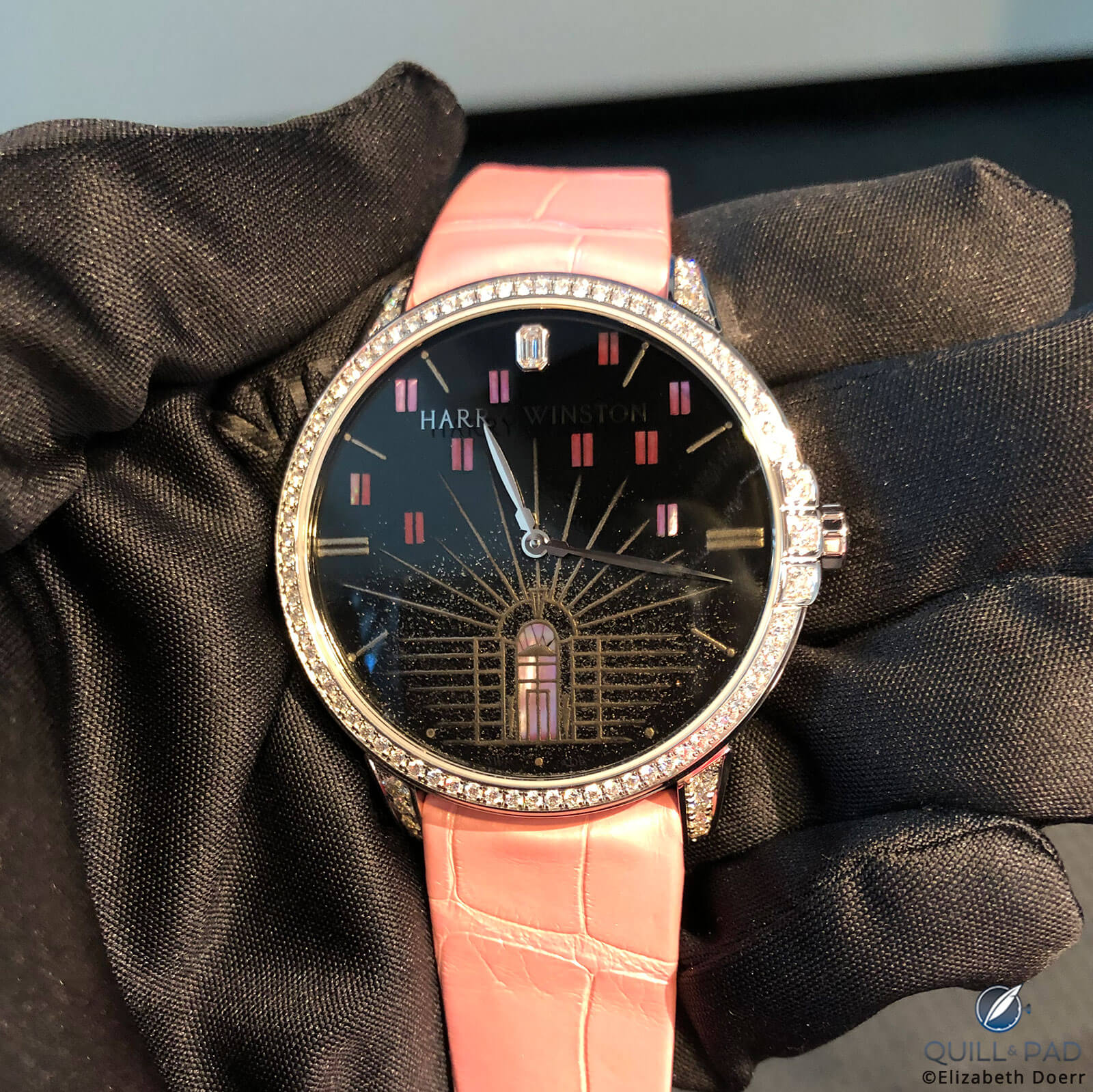
The “hers” portion of the Harry Winston Midnight Yozora limited edition set
MG: No, and not only the watches but also the pen. You know they’re just labors of love. It also helps that it was presented by the people who actually worked on the development of these watches and pen. These people were involved in the project and could provide inside information, but at the same time you could also taste their passion, their journey.
And I think that really made Time to Move in total such a different experience from SIHH and Baselworld. I do think Swatch Group has given itself the edge with it.
Glashütte Original
ED: Our very last stop was Glashütte Original.
MG: I was worried for that one because it was in a hotel.
ED: Right! And as we know, Glashütte Original is a brand that is located in Glashütte, Germany, not in Switzerland as the rest of the brands are, so we had no idea what to expect here.
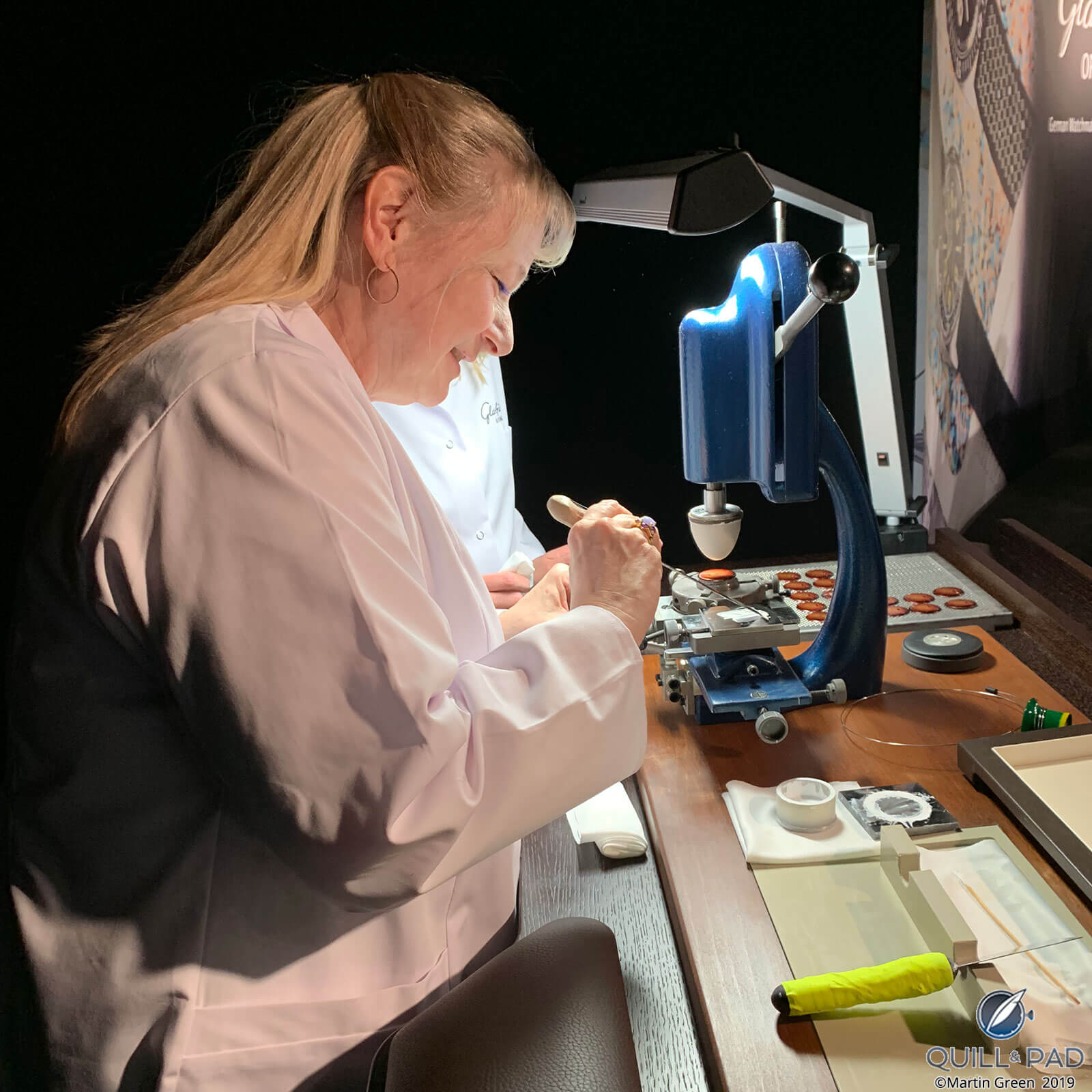
Elizabeth Doerr tries her hand at pad printing a Glashütte Original Sixties dial
So what the brand had done was set up a work station, like a lab, inside of one of the hotels in Geneva so that we could understand the testing and so on that goes into these watches. There was a dial printing station, where we were shown how the brand makes its dials.
There was another station where we could try to put together parts, screw in tiny little pieces that you can’t even see with the naked eye. That alongside the handful of new watches by this brand was very impressive and really left an amazing impression on me.
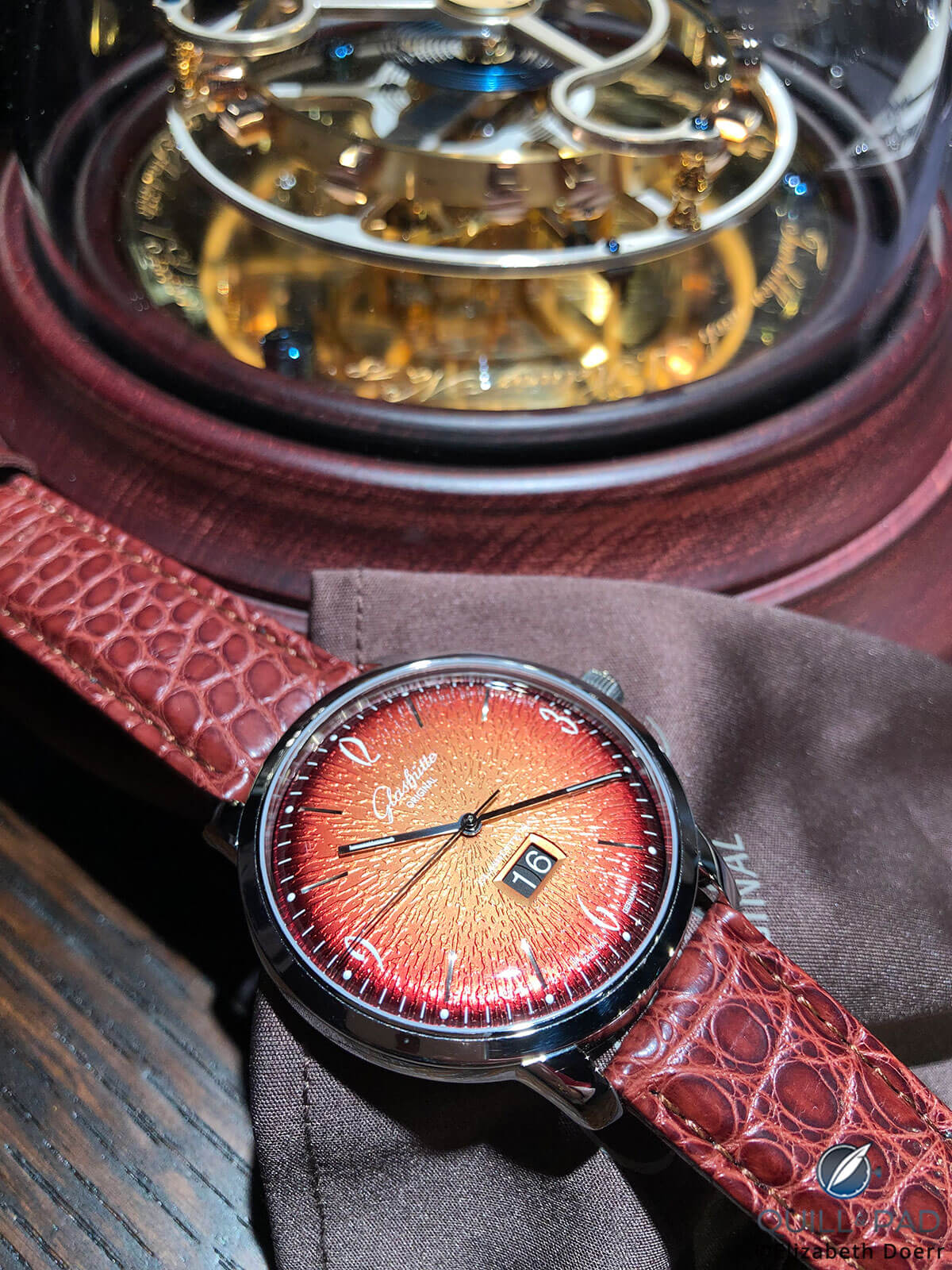
The 2019 annual edition of the Glashütte Original Sixties Panorama Date
MG: True, in particular, the latest annual edition of the Sixties/Sixties Panorama Date with a gorgeous burnt-orange dial, a color in which I wouldn’t want to own anything, but on this dial is so vibrant. It works so well, especially with the small-scale Louisiana alligator. Just perfect.
ED: And I was seriously impressed by the brand-new Senator Chronometer Tourbillon. You’d normally think to yourself, okay it’s another tourbillon. But this is not just another tourbillon. This is a unique timepiece, and you’ve never seen anything like it before. Basically, it’s a flying tourbillon – a type of tourbillon held by only a one-sided bridge called a cock that was invented by Alfred Helwig in 1920 in Glashütte – and this one hacks.
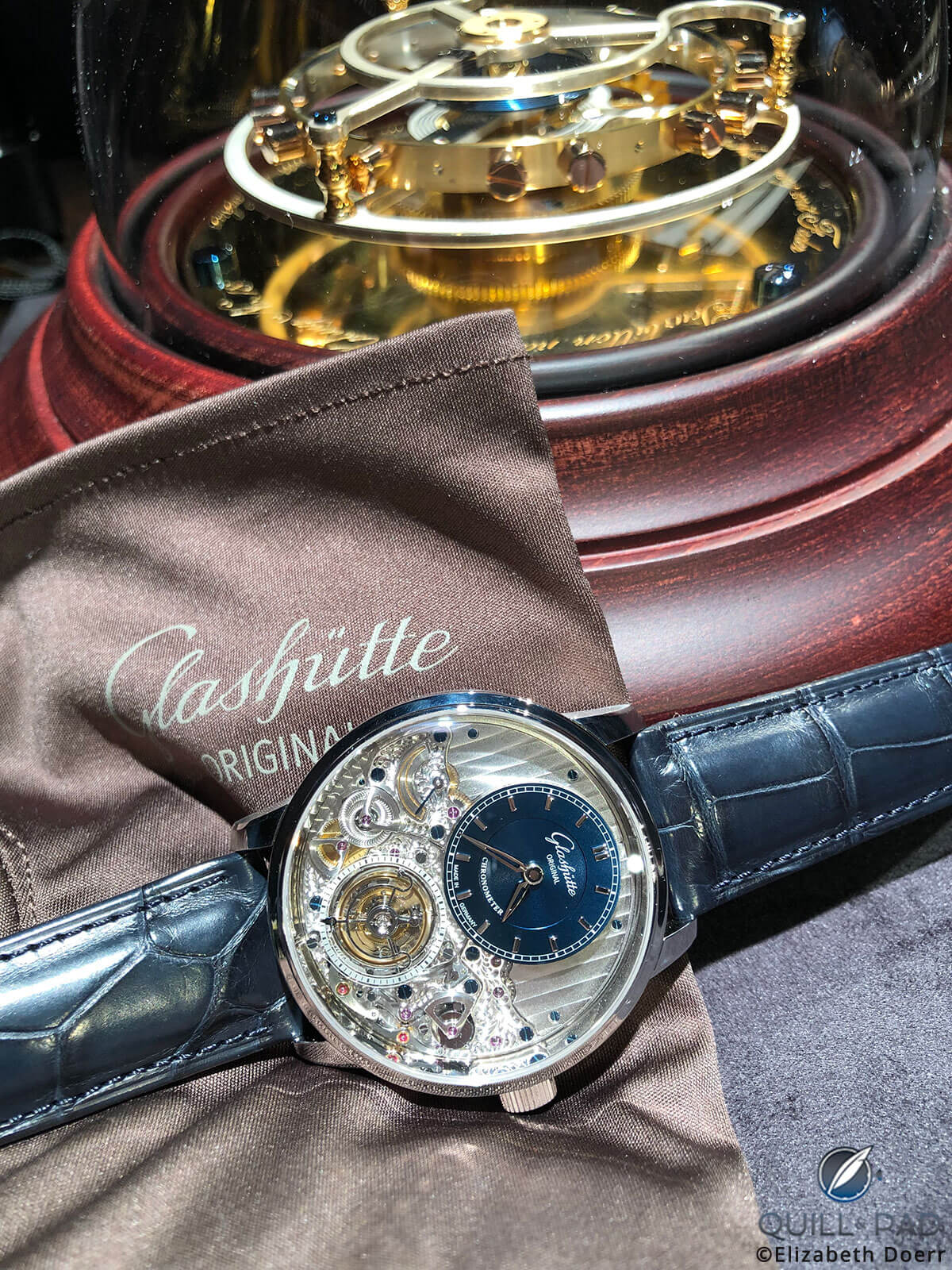
Glashütte Original Senator Chronometer Tourbillon
MG: If you pull the crown into the second setting, it actually hacks (stops) and then resets to zero!
ED: In addition to the tourbillon, there was a beautiful limited edition of the PanoInverse, which you might recall inversely presents the balance bridge and regulator on the dial side. And, no, there is no dial to speak of.
And the final watch I’m going to mention is the new diver, the SeaQ, which I found impressively attractive.
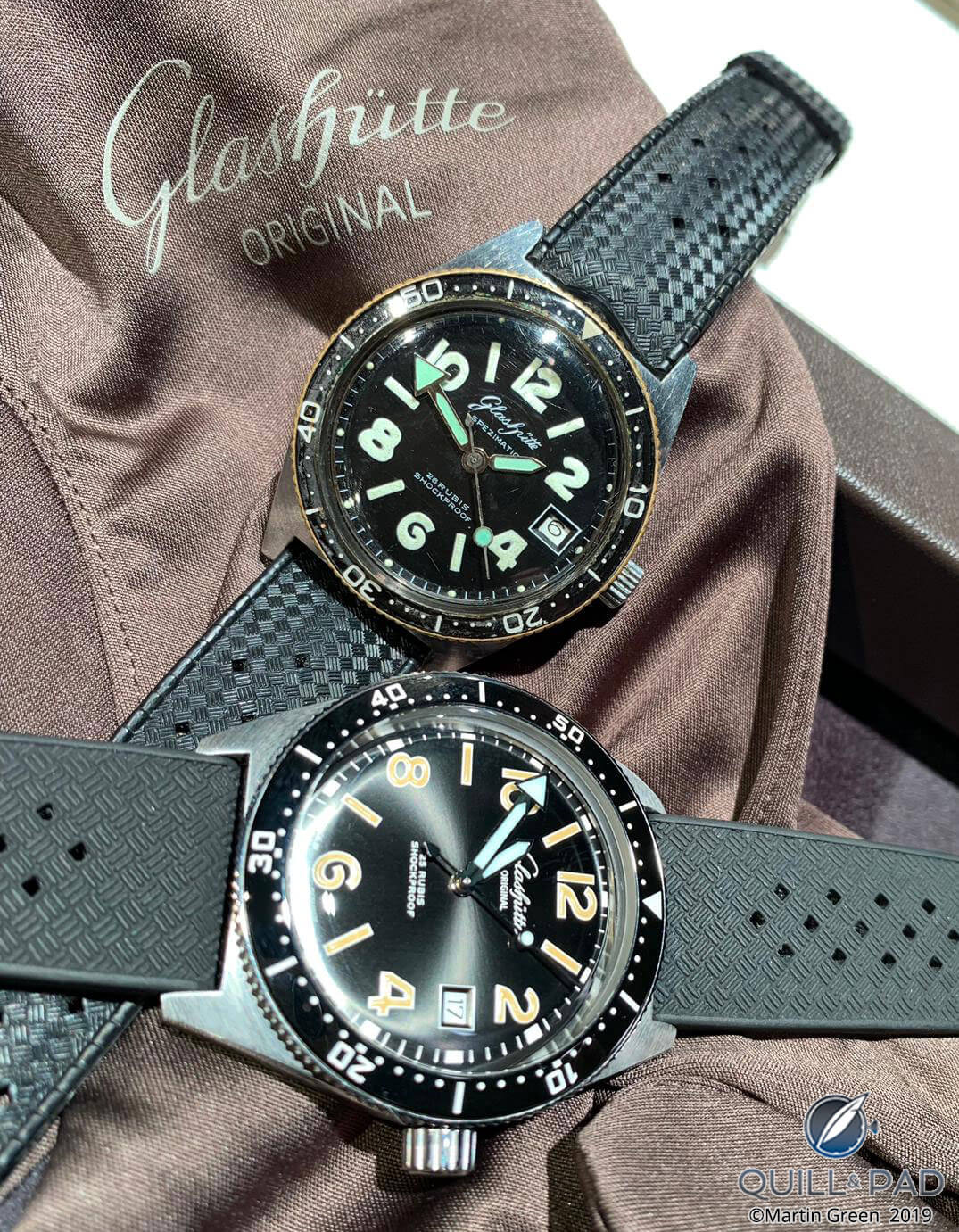
The Glashütte Original SeaQ 1969 limited edition with the original Spezimatic Type RP TS 200 from 1969 (top)
MG: Quite honestly, I wasn’t that impressed; but I was very impressed by the vintage version. The new version I probably still need to warm up to because, first of all, I’m a little bit disappointed that the metal bracelet does not have a wetsuit extension, which doesn’t make it really functional as a true diver’s watch.
Secondly, maybe I was too distracted by the vintage re-edition called SeaQ 1969, which I liked also because it was smaller in size at 39.5 mm.
ED: Yeah that’s the one I really liked.
Our favorites and what we would buy with our own money
MG: My personal favorite is the Magic Lotus Automaton by Jaquet Droz! Not only because it incorporates so many different metiers d’arts, but also how it unites them. The motion of the koi fish is lifelike, the automaton runs smoothly and is full of action, and the watch is even of a wearable size and with a generous power reserve!
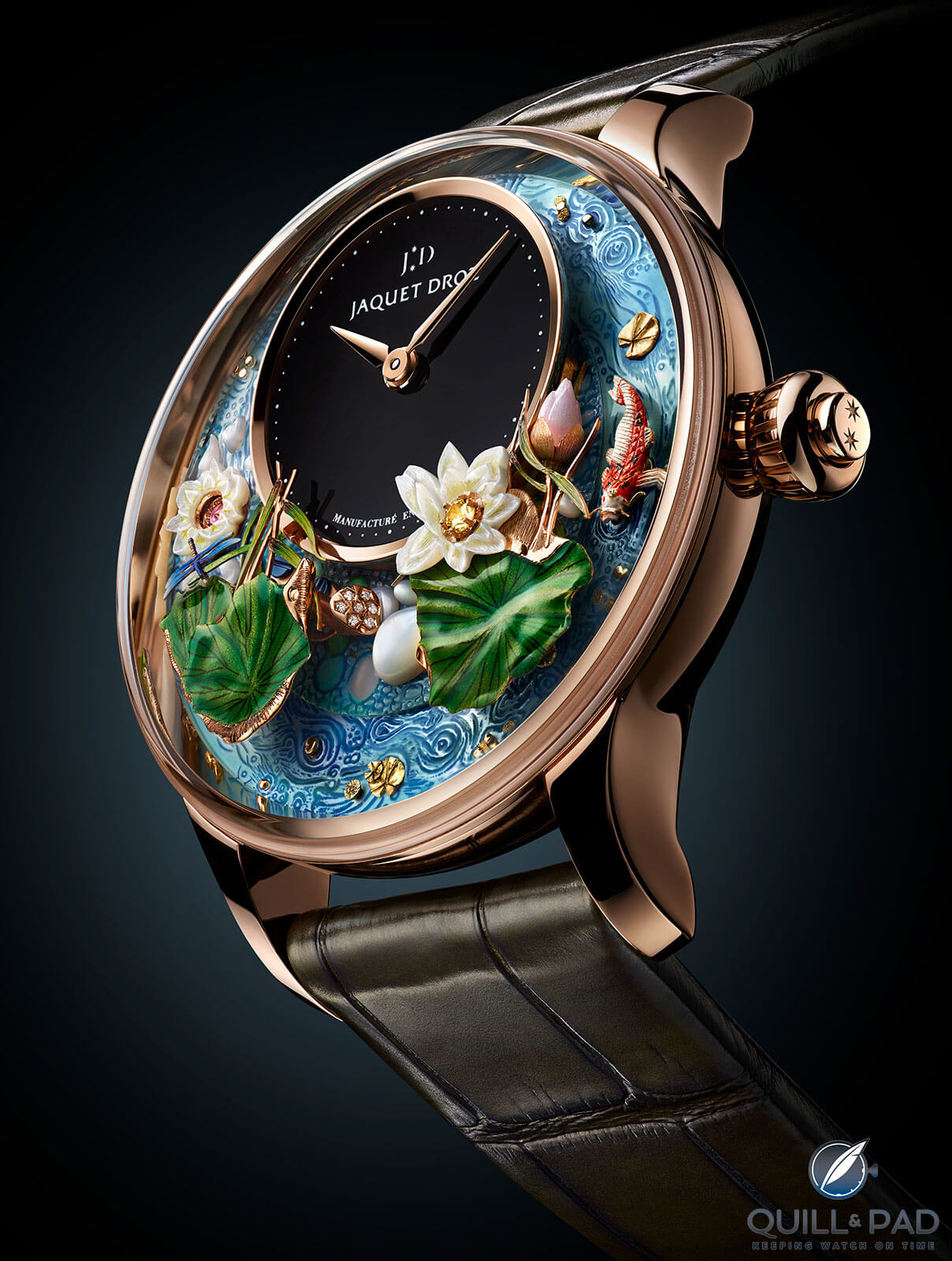
Jaquet Droz Magic Lotus Automaton
ED: That may have been my favorite, too, but it may also have been the Breguet Classique Tourbillon Extra-Plat Squelette or even the Glashütte Original Senator Chronometer Tourbillon. All three are just delightful and deserving of being anyone’s favorites.
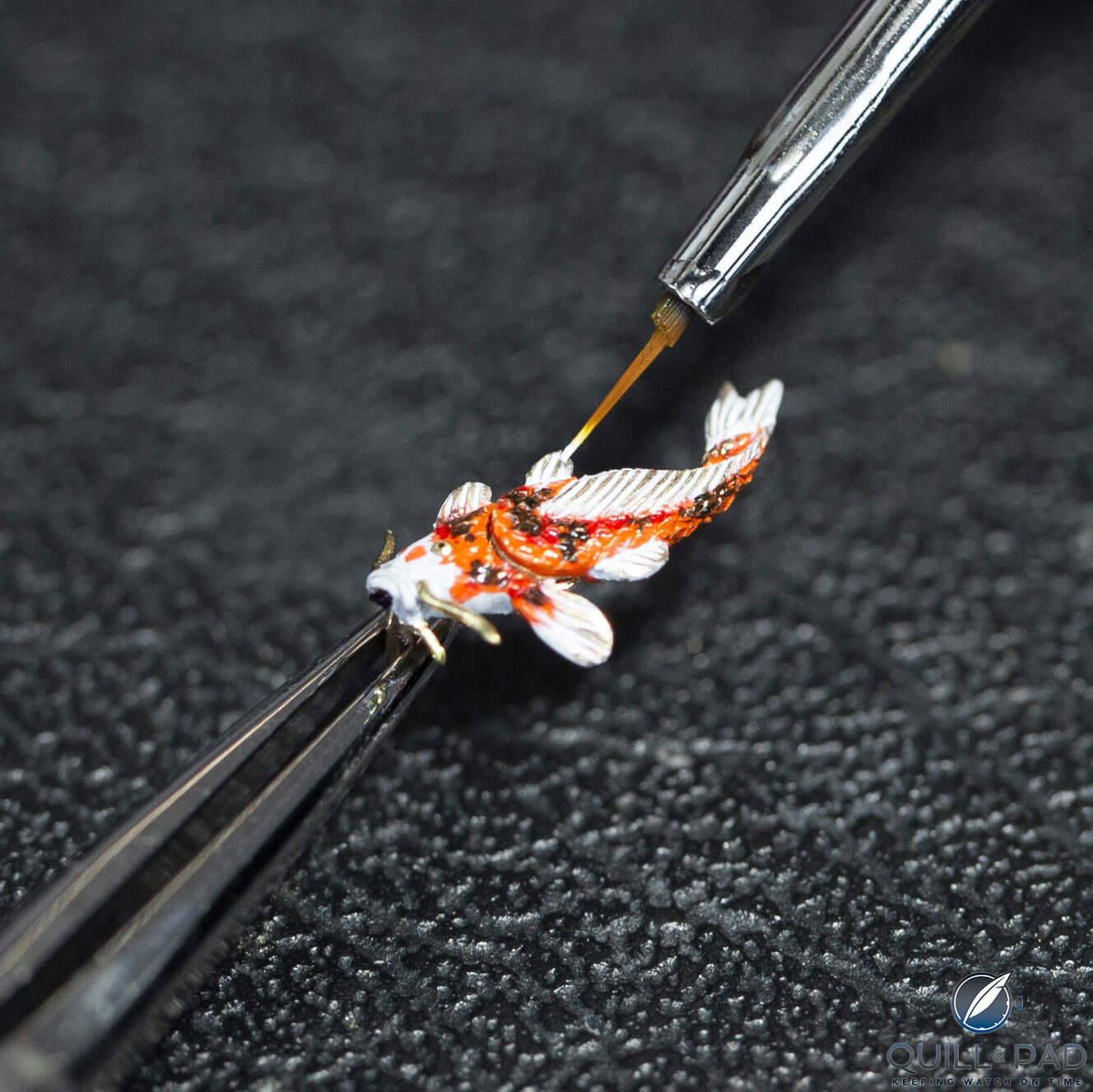
Artisanal koi carp from Jaquet Droz’s Magic Lotus Automaton
MG: And the watch I might be tempted to buy with my own money is Omega’s new Seamaster chronograph. I am utterly impressed by the way that Omega incorporated this complication into the latest generation of its iconic diver’s watch.
The readability is superb, the chronograph complication is included in such a way that it adds even more depth to the dial, and the watch is not unwearably large and bulky, either. This is how you make a diver’s chronograph!
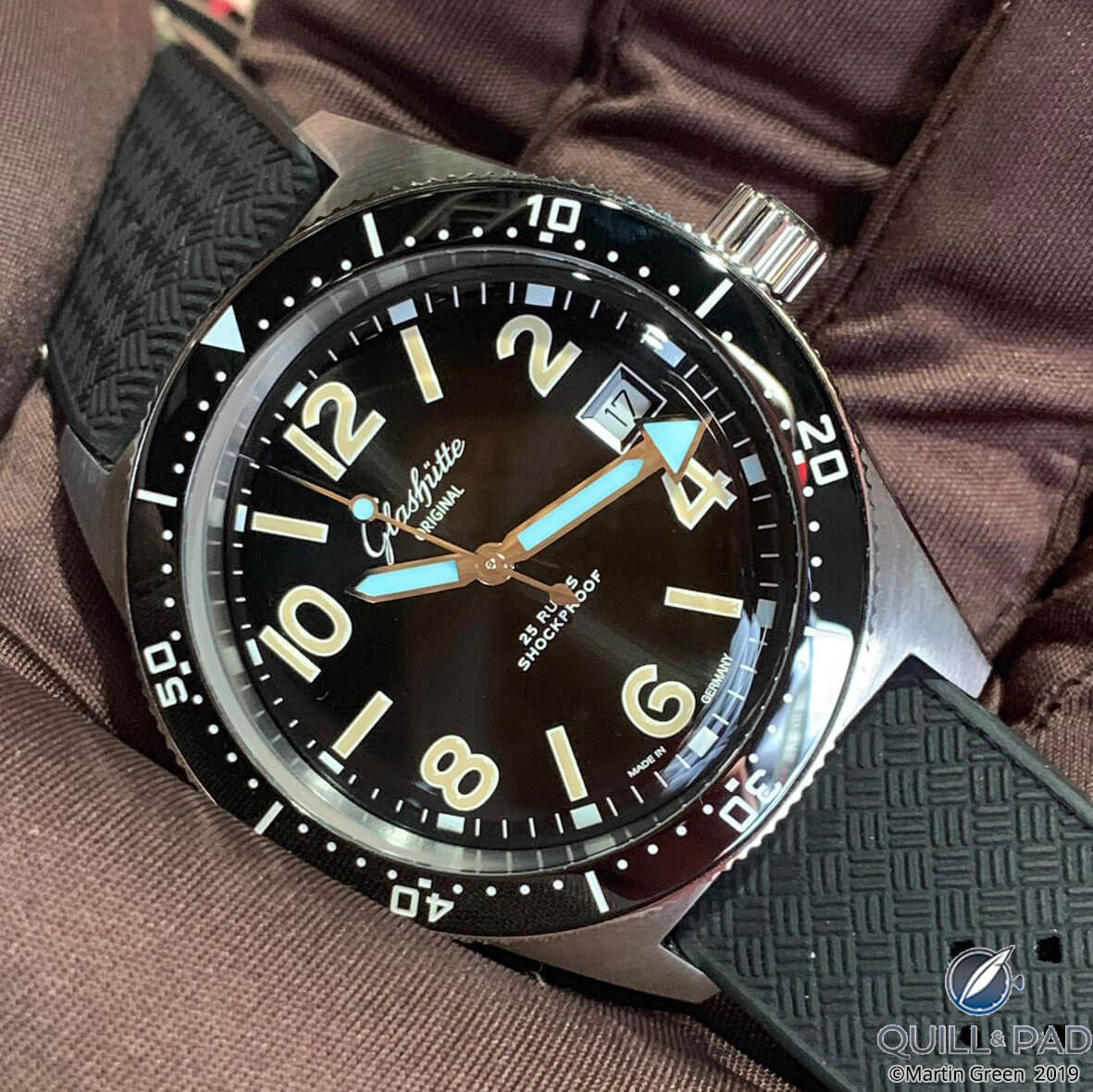
The Glashütte Original SeaQ 1969 limited edition
ED: The watch I could be tempted to buy with my own money is the Glashütte Original SeaQ 1969 limited edition, which is priced the same as the non-limited version, but only comes in an edition of 69 pieces. And the only thing distinguishing the two, which are modern re-editions of a 1969 Spezimatic watch, is the color of the hands (and the limitation number).
For a rare foray into this genre, Glashütte Original has done a fabulous job of it.
Quick Facts Jaquet Droz Magic Lotus Automaton
Case: 43 x 16.96 mm, red or white gold
Movement: automatic Caliber 2653 AT2 with silicon balance spring and pallet fork; twin spring barrel, 68-hour power reserve, 56 jewels, 4 Hz/28,800 vph frequency
Dial: hand-engraved and -painted white mother-of-pearl, black onyx subdial
Functions: hours, minutes; power reserve indication (dragonfly); hand-wound automaton with pond, carp, and lotus flower set with 7 diamonds or yellow sapphire or ruby or blue sapphire as changing pistils
Limitation: 28 pieces in each case metal
Price: approx. $240,000
Quick Facts Breguet Classique Tourbillon Extra-Plat Squelette Reference 5395
Case: 41 x 7.7 mm, pink gold or platinum
Movement: automatic Caliber 581SQ with one-minute tourbillon, extra-thin at 3 mm in height, with silicon balance spring and pallet fork, reverse-side Swiss lever escapement and titanium tourbillon carriage; peripheral rotor, 80-hour power reserve, 4 Hz/28,800 vph frequency
Functions: hours, minutes, seconds
Price: CHF 220,000 (pink gold), CHF 235,000 (platinum)
You may also enjoy:
Parting Thoughts (All 23 Of Them) From Baselworld 2019
Baselworld Becomes The Story: Baselworld 2020 And Beyond Will See Big (And Positive) Changes
Leave a Reply
Want to join the discussion?Feel free to contribute!





















































Awesome designs. Any idea how much is the Blancpain Villeret Bracelet?
No, I couldn’t say how much the bracelet surcharge is. I do know it is hand-assembled and contains about 1,000 links!
This was a nice roundup, thank you for posting.
The GO diver just seems to be a lazy attempt to cash in on the vintage reissue trend, as that design is pretty generic for skin divers from the 60s, there were many brands making divers with that case shape, similar arrow hands etc. (Vantage by hamilton is a good example, there is one that looks very very similar to the GO watch) I wouldn’t be surprised that was a marketing department driven project.
Our pleasure. I hear you, but I really like the GO piece nonetheless. This sort of piece is only very rarely in a size I can wear, and this one is. Might be a big reason I liked it so much.
The Jaquet Droz Grande Seconde models were the stars for me – the monopusher Chronograph, and the Dual Time, both in gold case/ivory enamel.
I’ve always liked that collection in general, and these just made it better. Would like them to see if they can bring the diameter down a leeetle bit in future, though.
Seriously have to agree with you! Jaquet Droz probably won the event. And I’m not the only one who’s been saying that.
Of course, that automaton piece was remarkable too, as are all the automata they do. I love what Swatch have done with JD – some ‘Lazarus’ brands (as I like to call them) just don’t get handled the right way after revival, but Hayek got it perfectly right.
. . . in great part due to the technical expertise of CEO Christian Lattmann, who used to be at Breguet. He is an excellent leader and thinker, I find.
Indeed yes, Lattmann. And I’ve just been looking at the Grande Seconde collection on their site again, noticing something I missed before – most of the models come in smaller 39mm versions as well as the standard 43mm size, so forget what I said about needing to bring the diameter down.